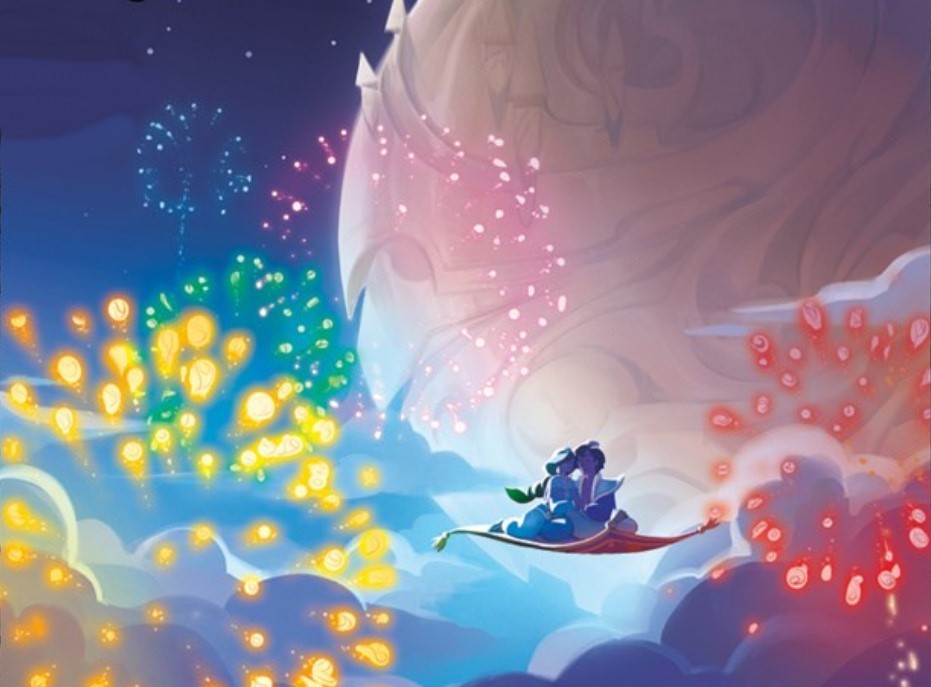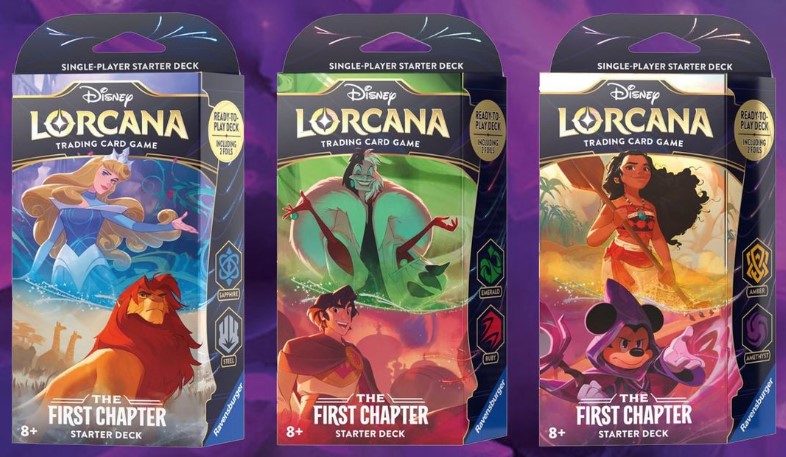Greetings, Illumineers! Disney Lorcana‘s The First Chapter officially releases in big box stores today, so I figured what better time to take a closer look at what the first set of the hottest new trading card game (TCG) has to offer.
In this set review, we’ll be examining the key cards, mechanics, and gameplans for each ink identity, the early Constructed metagame, decklists, and what to expect when getting into the rapidly growing community. I’d like to extend a big thank you to Lorcana Decks on X/Twitter for aiding in my decklist research and DreamBorn for their super easy to use deckbuilding tool.
If you’re just starting your Lorcana journey, I recommend reading my complete beginner’s guide, which covers how to play Lorcana, the rules, keywords, mechanics, and more.
Starter Decks
Starter Decks are often looked down upon in the TCG world, as they typically include cheap cards and the most base-level strategies the game has to offer. As a TCG veteran, I was pleasantly surprised with the quality of the Lorcana Starter Decks. There are three decks total, featuring Sapphire/Steel, Ruby/Emerald, and Amber/Amethyst ink combinations, and each deck comes with two foil “face cards” – one rare and the other super rare.
I taught my wife how to play using these Starter Decks, and while the decks are synergistically simple, they’re not so watered down that every game feels the same. After our first couple matches, it became clear that the Sapphire/Steel and Amber/Amethyst decks were a tier above the Ruby/Emerald deck, but each was enjoyable to pilot and had fun pseudo-combos to discover.
Once we had played several games with each deck, we decided to try separating out the inks and mixing and matching – something that you really can’t do with starter decks in other card games. To our surprise, there was very little disconnect in the synergy when mixing the inks, and in some cases, felt like we actually powered up our gameplay. When we mixed ruby and amethyst for example, the deck felt much stronger compared to the other combinations.
Overall, I would highly recommend new players pick up one of each Starter Deck, as they’re a great place to start building your collection since the supply of booster packs is likely to be inconsistent through the end of the year. Plus, each Lorcana Starter Deck comes with a booster pack!
Ink Identities

Lorcana’s six magical inks are best compared to the colors in Magic: The Gathering. Over the years, each of Magic’s five colors have formed their own identity that shapes archetypes, patterns of play, and ultimately tells players what to expect when playing with or against that color. This concept applies directly to Lorcana, but Magic has had 30 years to solidify their color identities, and as such, subsequent set releases will likely alter Lorcana’s ink identities in the years to come.
In The First Chapter, each ink has been assigned a general “theme(s)” that defines the qualities of cards within. While Lorcana’s various keywords and mechanics appear across all six inks, certain ones may be more prevalent or have better synergy within a specific ink or ink combination. Let’s take a look at each one and break down what they do best.
Amber
Amber glimmers are purposeful. Patient and dedicated, they’re able to pursue causes and ambitions with single-minded persistence. They often work within communities, either from above as a leader or from within as a healer, bodyguard, or just a loyal follower.
Ravensburger
Key Cards
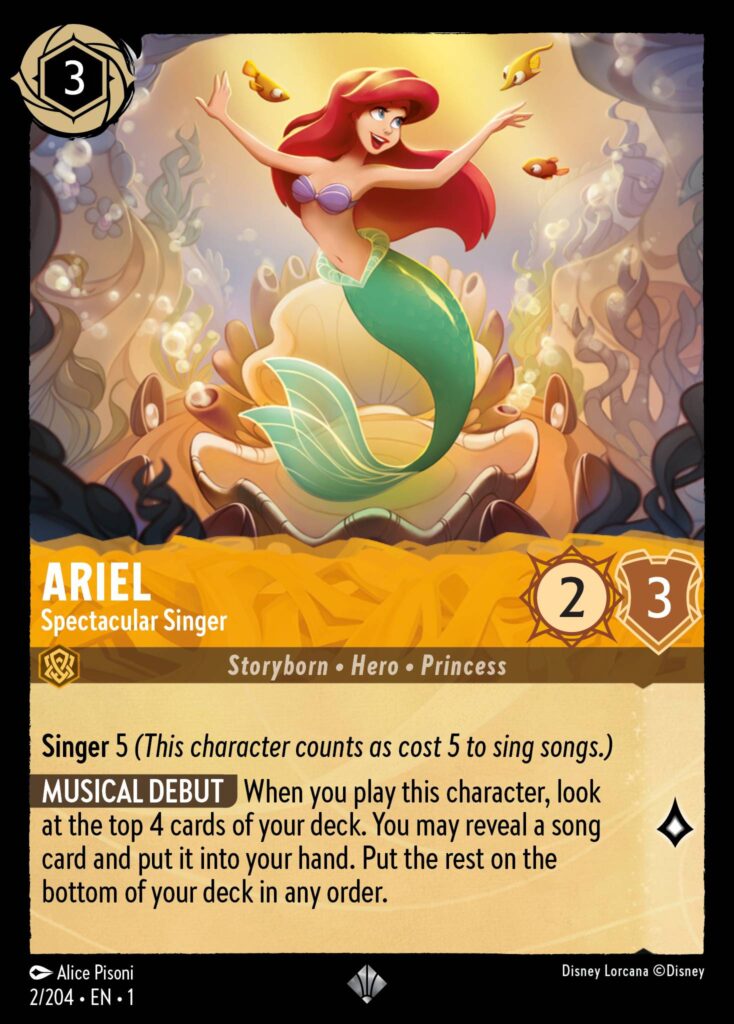
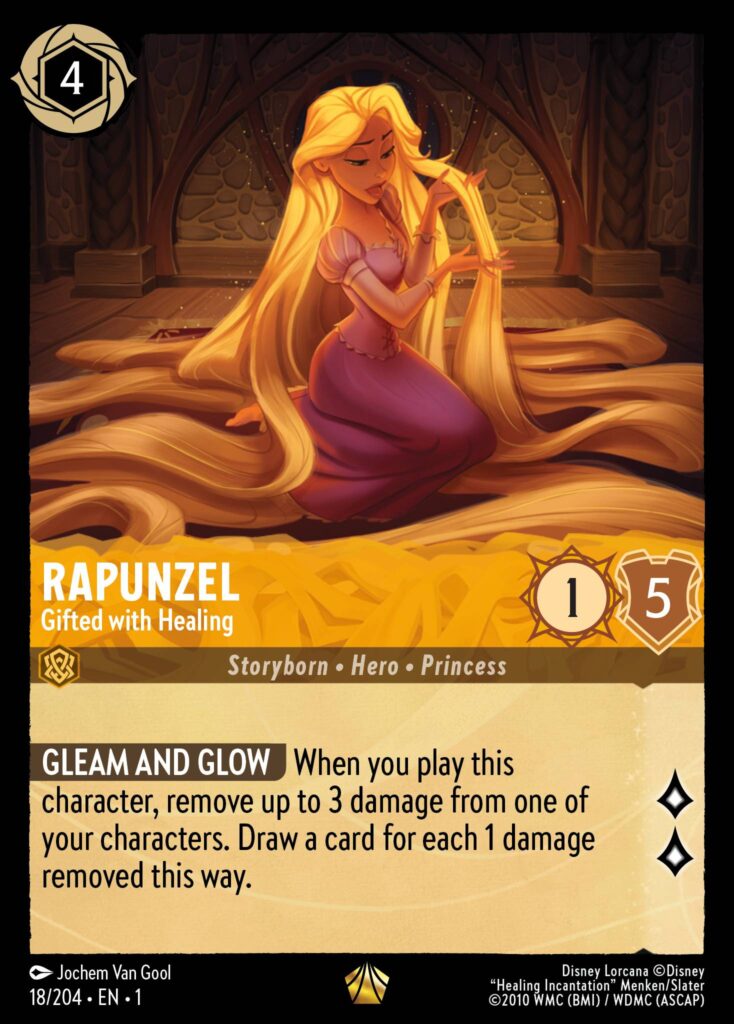
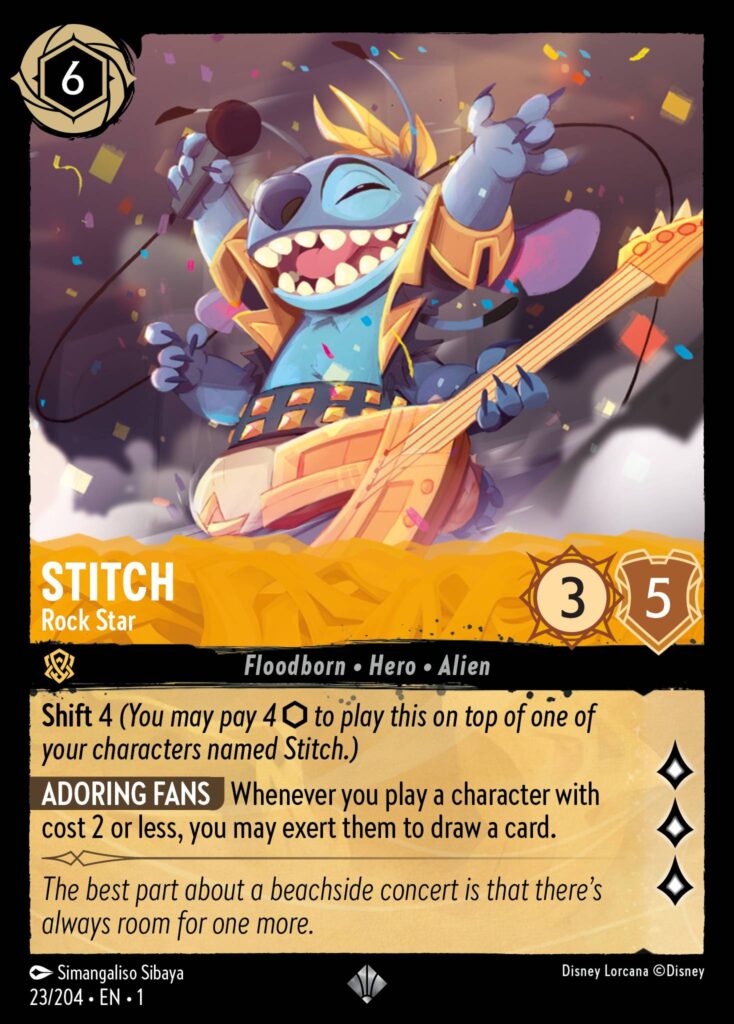
Key Mechanics
- Singer
- Shift
Main Themes
- Singing songs
- Healing
- Princess synergy
Amber’s role in The First Chapter is one many didn’t see coming. Back when all of the set’s 204 cards were previewed, many identified amber as the definitive song-enabling ink. Cards like Ariel, Spectacular Singer; Ursula’s Shell Necklace; and Be Our Guest were slam dunks for song decks, and yet, we’ve yet to see one make waves. Being just two weeks deep into the tabletop metagame, it’s still way too early to say there won’t be a dedicated song deck, but for now, amber decks have gone in a totally different direction.
Enter Stitch, Rock Star – a six-cost super rare that flew under the radar for months. The combination of being somewhat expensive plus most players not fully understanding the shift mechanic lead to many underrating this card-advantage powerhouse.
In the last week or so leading up to Lorcana’s LGS release, decks featuring tons of low-cost/high lore value cards started appearing more frequently on the various digital Lorcana simulators, with Stitch, Rock Star at the helm. This unlikely hero had found himself as the primary source of card draw for amber-based aggro decks.
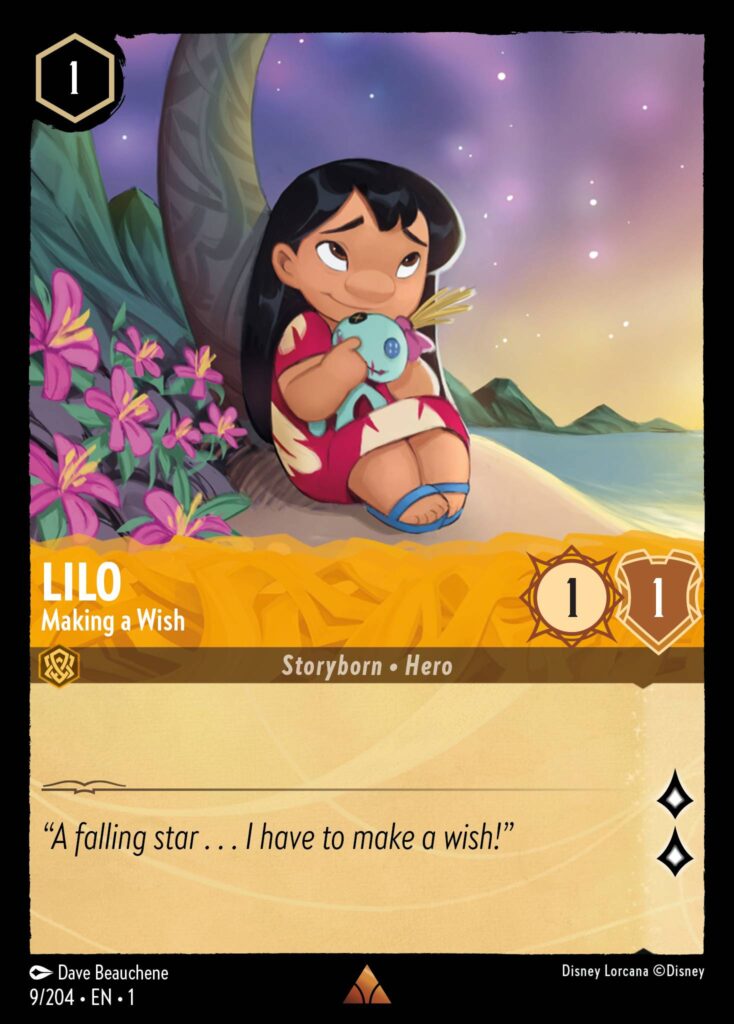
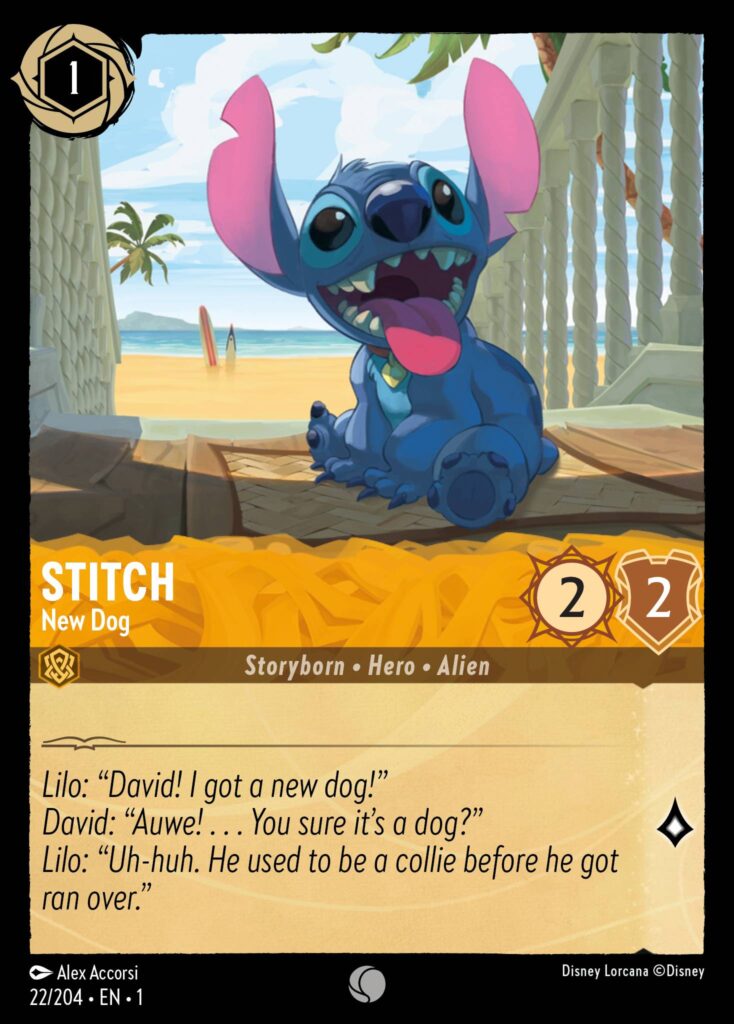
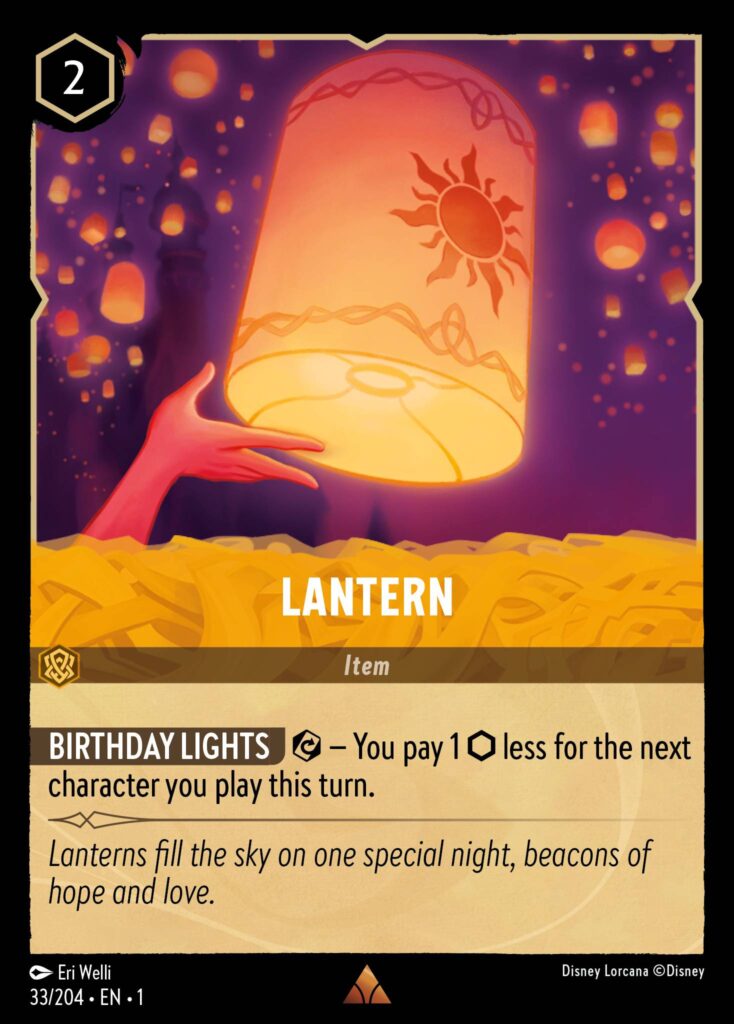
For those unfamiliar, the term “aggro” is short for “aggressive”, and in this case, refers to a strategy that seeks to put lots of low-cost cards into play and gain enough of an advantage to win before the opponent can stabilize.
Cards like Lilo, Making a Wish and Stitch, New Dog were just two of the many cheap threats packed into the amber/x aggro shell, with the purpose of getting characters into play as fast as possible, and then using some number of Lanterns or shifting using Stitch, New Dog to get Stitch, Rock Star into play ahead of curve. Once in play, Stitch, Rock Star turns all of your one and two-cost characters into draw effects – allowing you to flood the board and refill your hand at the same time. Without cheap characters of their own or a proper sweeper effect like Be Prepared or Grab Your Sword, players facing down this type of strategy would quickly find themselves at an extreme disadvantage. For those unfamiliar, sweepers are cards that affect multiple targets at once. Be Prepared for example, banishes all characters, including your own, while Grab Your Sword deals two damage to all of your opponent’s characters.
Now, you’re probably wondering where Rapunzel, Gifted with Healing fits in all this. The answer is… everywhere. Upon being previewed, Rapunzel was identified as one of Lorcana’s best cards, and she has yet to disappoint. If a deck is playing amber, she’s almost always going to be included. The combination of healing, drawing cards, and being able to quest for two lore makes her an extremely flexible mid-game card that has value in any amber-based archetype.
Popular Decklists
Amber/Emerald Aggro – by Lorcana Decklists
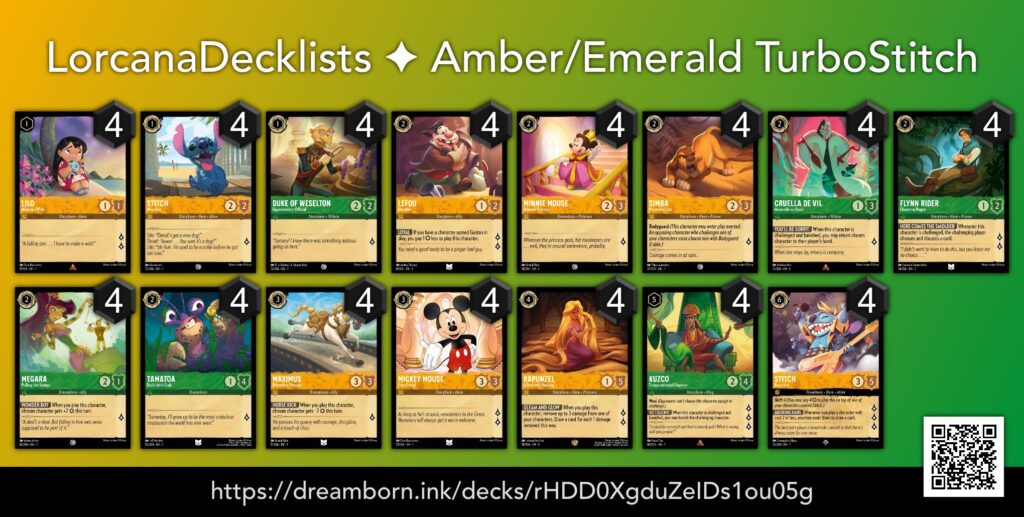
Amber/Steel Songs – by Lorcana Decklists
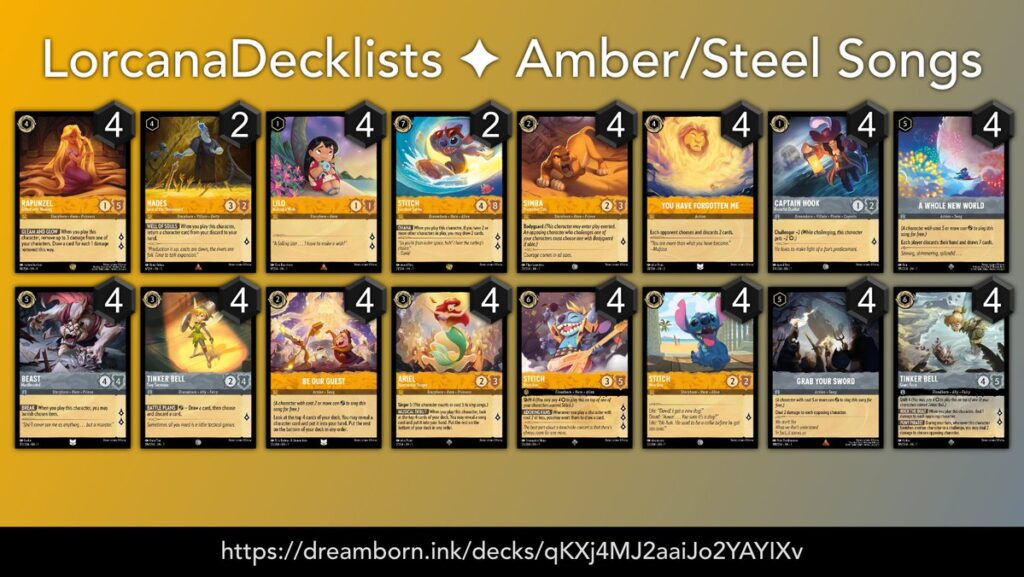
Amethyst
Amethyst glimmers are wondrous, for this is the otherworldly ink of sorcerers, sages, animated objects, and other glimmers who use their special powers to achieve their aims. They are incredibly powerful when they have access to their amazing abilities but may land in trouble if they’re stripped of those or tap into power they can’t control.
Ravensburger
Key Cards
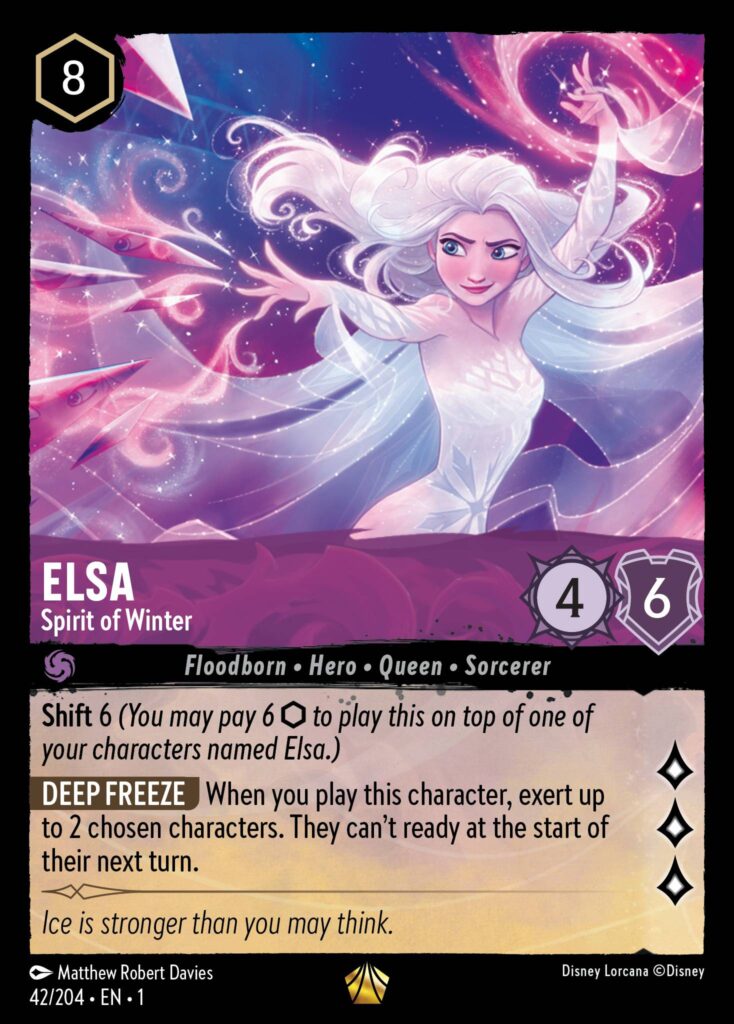
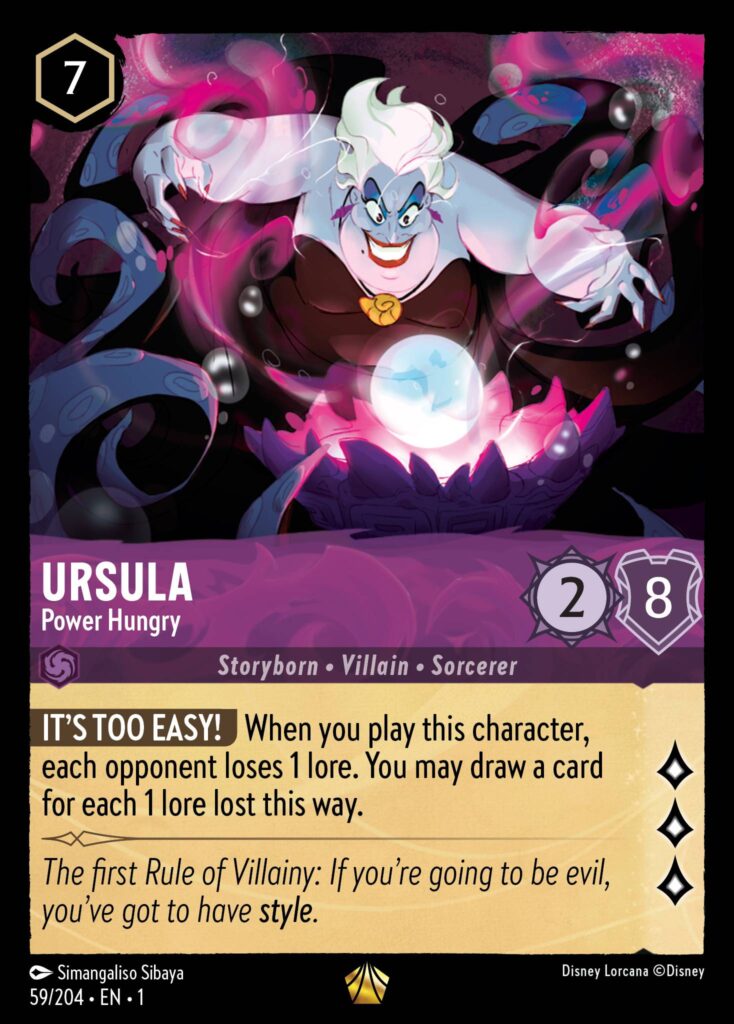
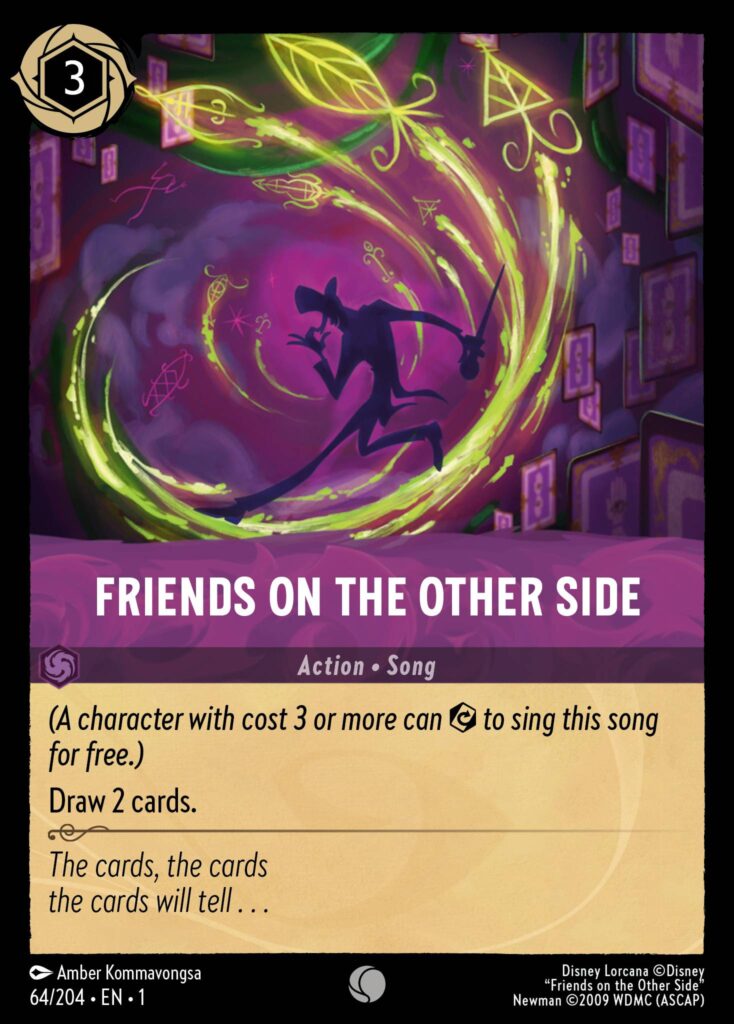
Key Mechanics
- Shift
- Rush
- Challenger
Main Themes
- Card draw
- Recycle
- Freeze (forced exertion)
Aside from being my personal favorite, amethyst is also widely regarded as the strongest overall ink. As with many TCGs, card draw is king, and Lorcana is no exception. Two of the game’s best card draw effects are cheap and appear at common-rarity in amethyst (Friends on the Other Side; Maleficent, Sorceress), while higher-cost (and rarity) options such as The Queen, Wicked and Vain and Magic Mirror provide strong, recurring mid-game draw support. No other ink has access to this quality (or quantity) of card draw, making amethyst the go-to ink for control shells.
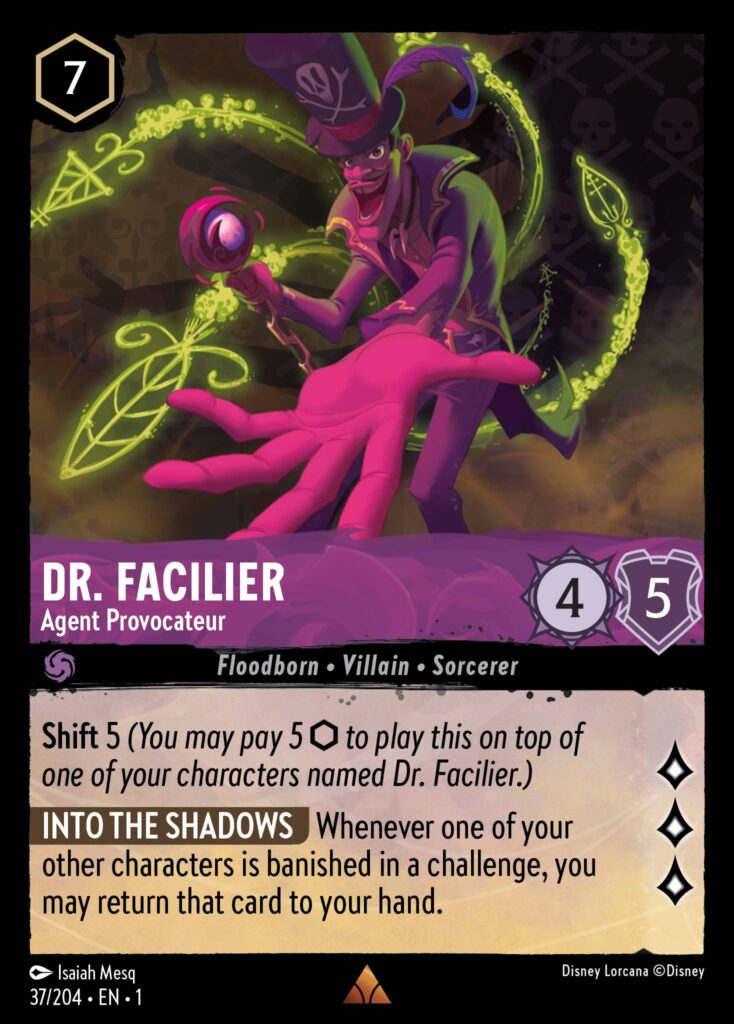
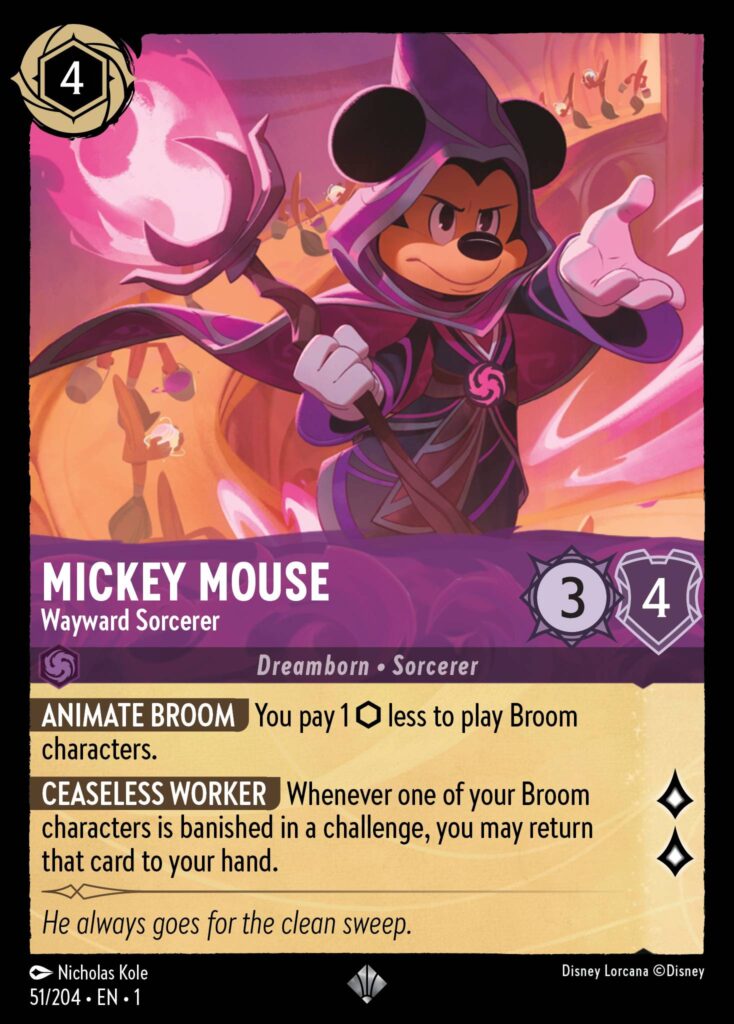
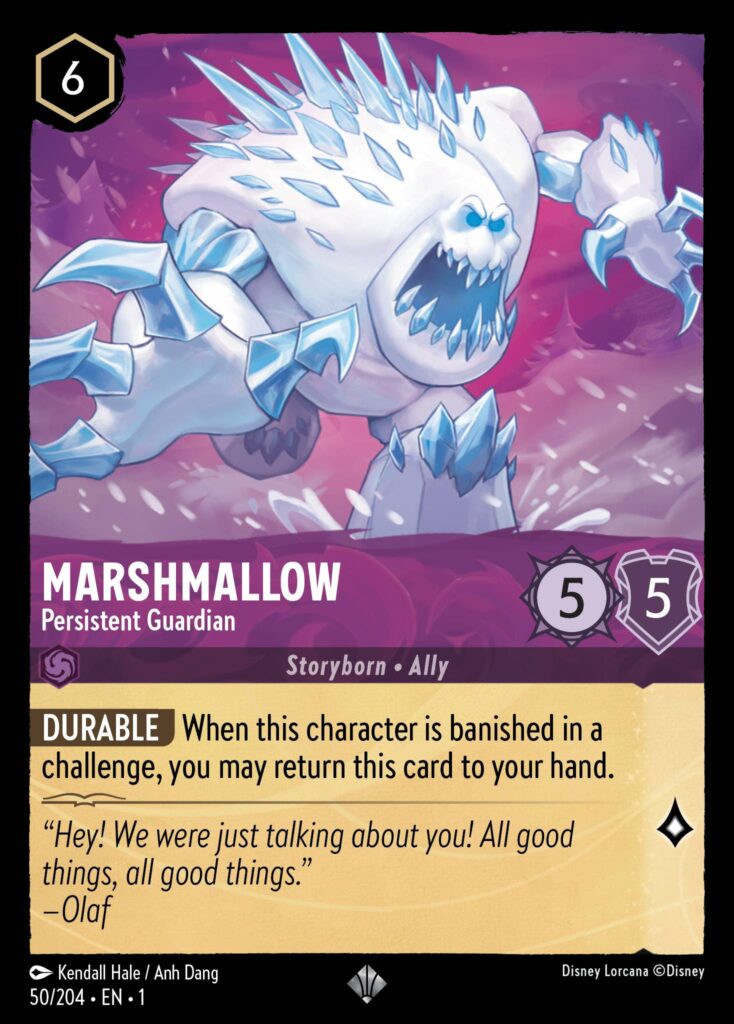
Another theme that is unique to amethyst is recycling. Early on, Dr. Facilier, Agent Provocateur was one of amethyst’s strongest characters, thanks to his Into the Shadows ability, which gives you the option to return any of your banished glimmers back to your hand. Pair this ability with shift 5, two other cheaper Dr. Facilier cards in the same ink, and one of the game’s best rushers in Rafiki, Mysterious Sage, and you’ve got a strong shell that provides a lot of card advantage.
As the early metagame continues to evolve, many control decks have moved away from the good doctor in favor of Mickey, Wayward Sorcerer. This super rare Mickey has a similar recycle effect, but only for your Broom characters. Mickey is also cheaper, inkable, and the accompanying Brooms allow you to return cards from your discard pile back to your deck – providing insurance against decks that aim to win through deck out (more on this later). The end result is a more tempo-oriented deck that can play the control seat by utilizing recycled characters, but also close out games quicker than pure control.
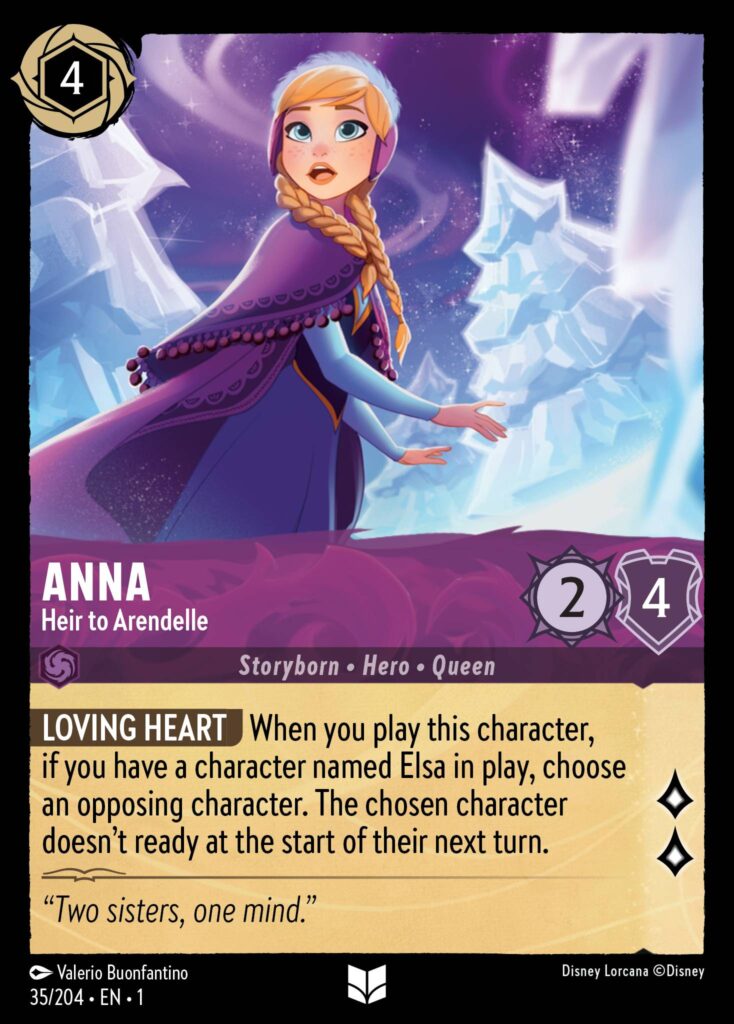
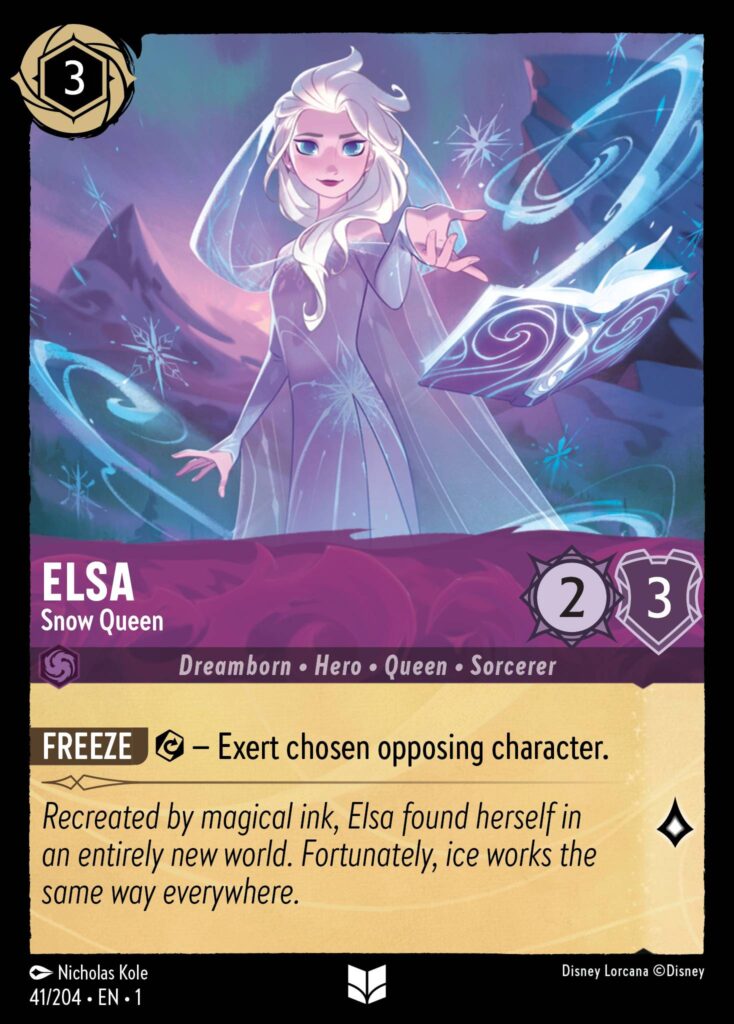
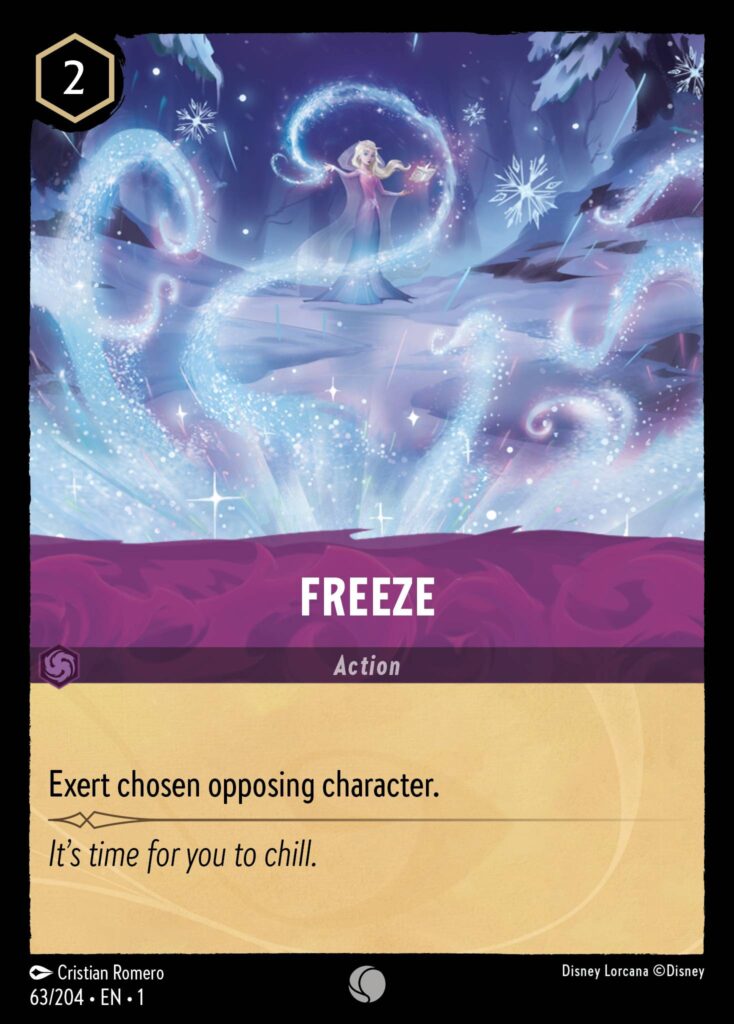
Freeze is yet another theme in amethyst’s toolbox. Freeze effects force characters to exert – leaving them open to a challenge. While cards like Elsa, Spirit of Winter and Elsa, Snow Queen do the freezing, cards like Anna, Heir to Arendelle and various rush characters take advantage of the exerted glimmers.
Popular Decks
Amethyst/Ruby Tempo – by LunaLove
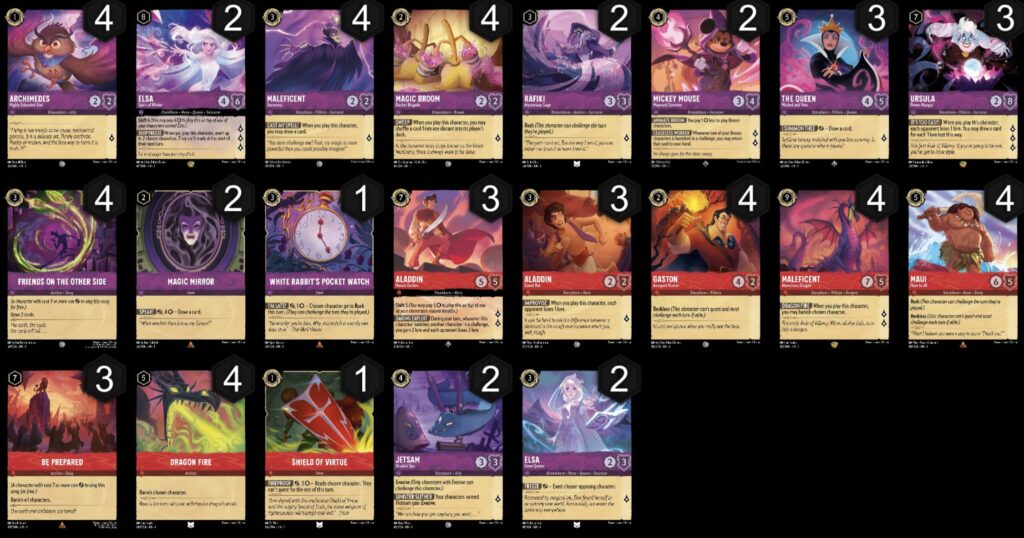
Emerald
Emerald glimmers are flexible. Gifted with the ability to adapt to changing circumstances, they are never caught off guard. Quick-thinking but not necessarily book-smart, they navigate their environment—whether physical or social, natural or artificial—with ease.
Ravensburger
Key Cards
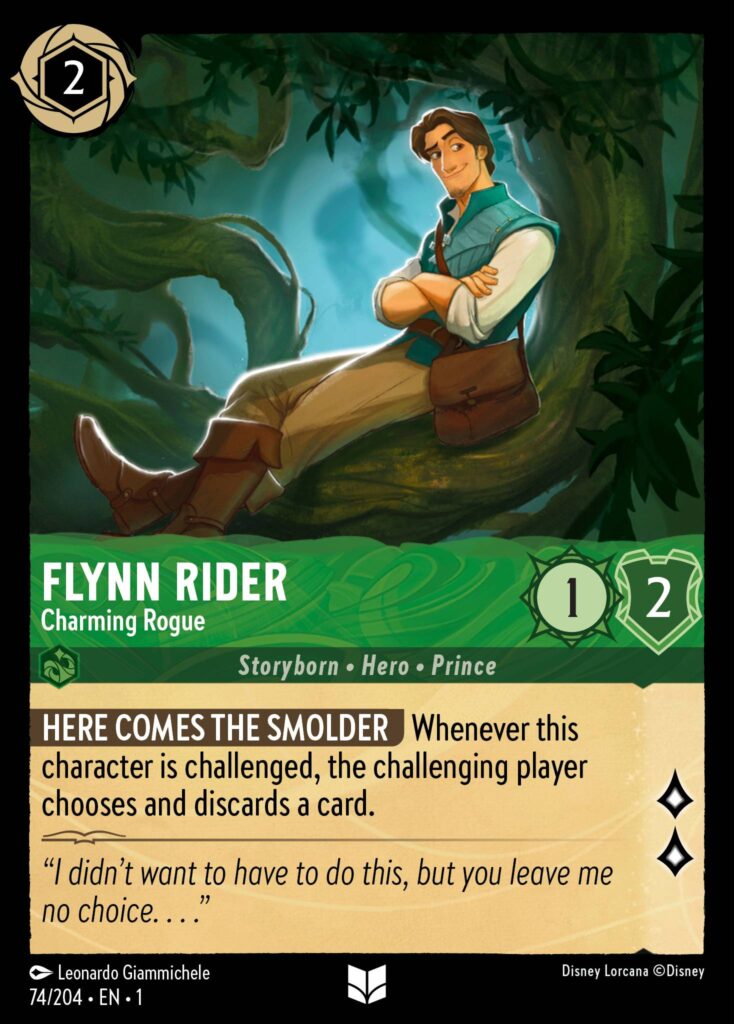
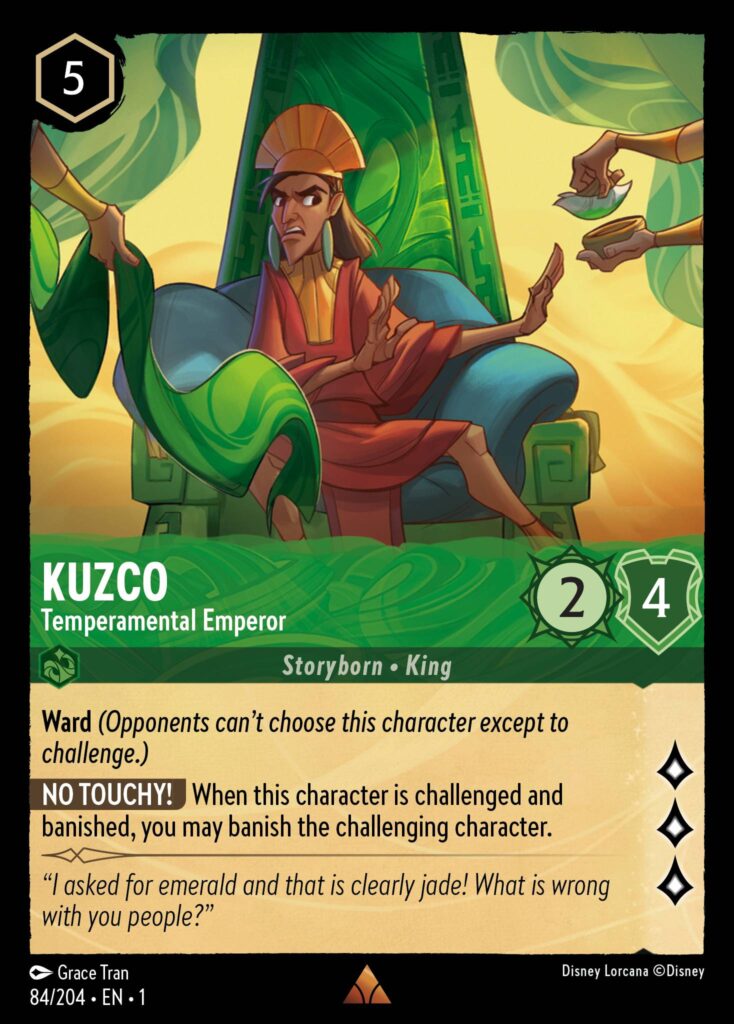
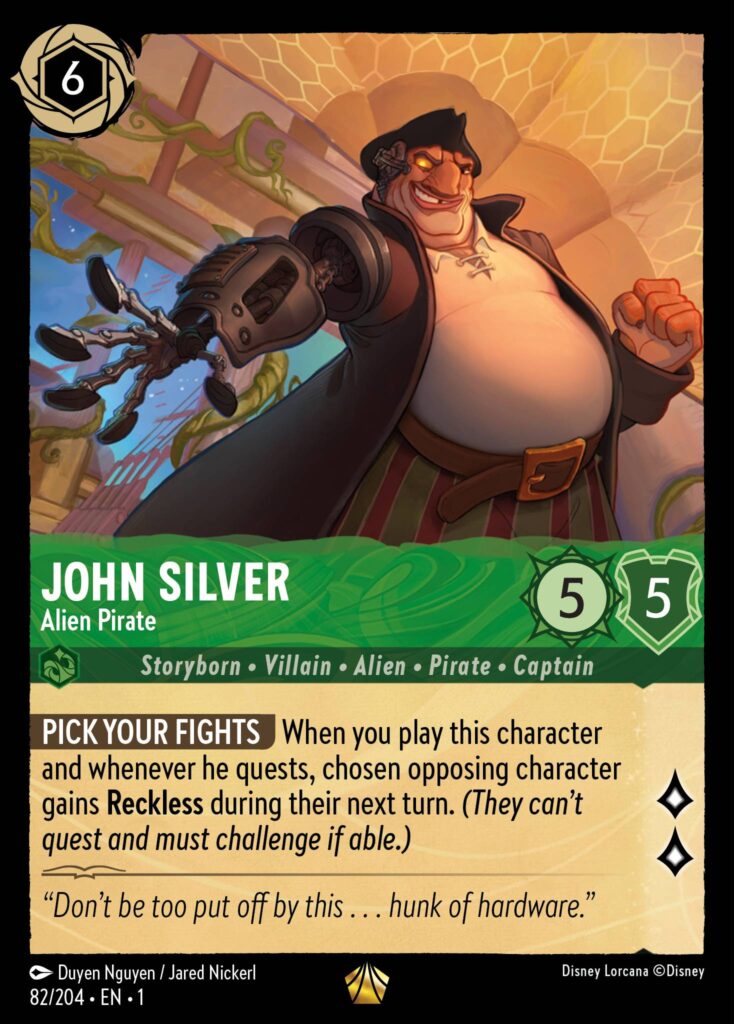
Key Mechanics
- Ward
- Evasive
Main Themes
- Challenge effects
- Character manipulation
Emerald is one of Lorcana’s most complex inks, and players attempting to build decks around it may run into issues of synergy and card quality. This isn’t to say that emerald is weak, or doesn’t have good cards. Quite the opposite, actually. It’s more so the fact that many of emerald’s cards play better in conjunction with other inks, rather than with themselves. Let’s look at Dr. Facilier’s Cards and Do It Again as an example.
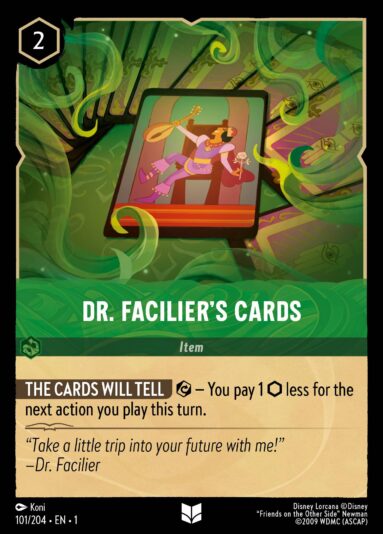
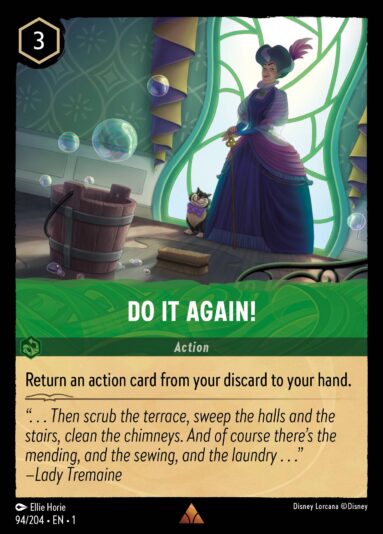
Dr. Facilier’s Cards provides a recurring discount to your actions, but it isn’t worth playing in a dedicated emerald deck, where most of your actions are much lower quality compared to the other inks. The same can be said for Do It Again. To best make use of these cards, they should be included as the minority ink in a broader strategy. Most commonly, you’d see these cards paired with steel, due to the high quality of steel’s action cards. This aspect of deckbuilding with emerald will likely be hard to grasp for newer players, but will ultimately reward those who put the time into finding the right balance.
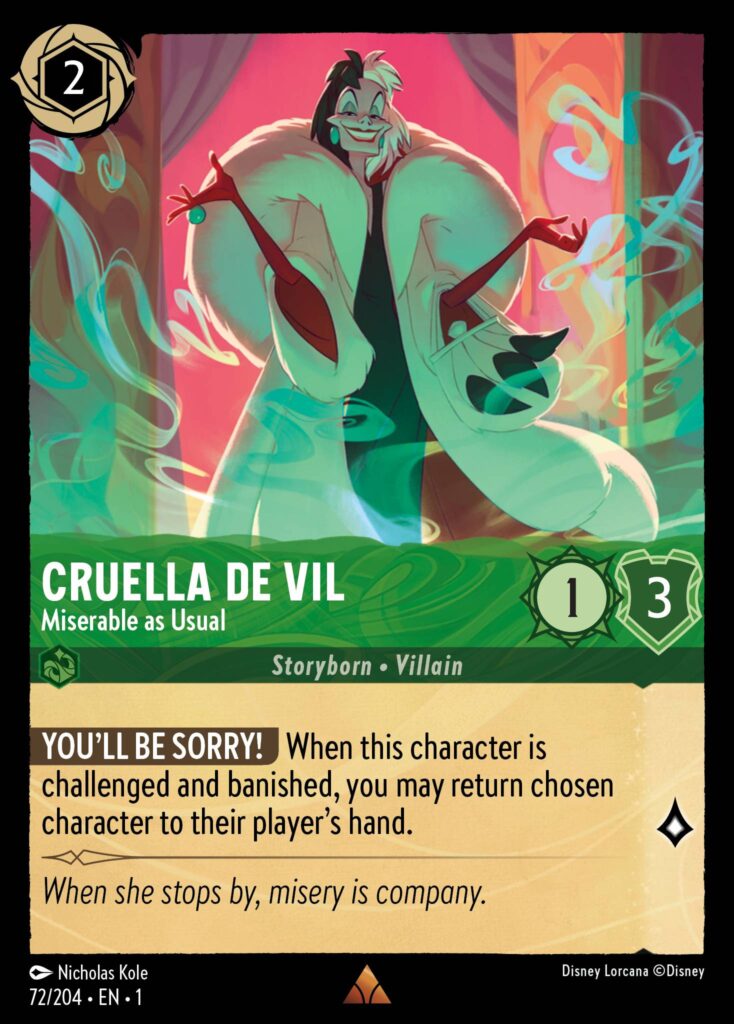
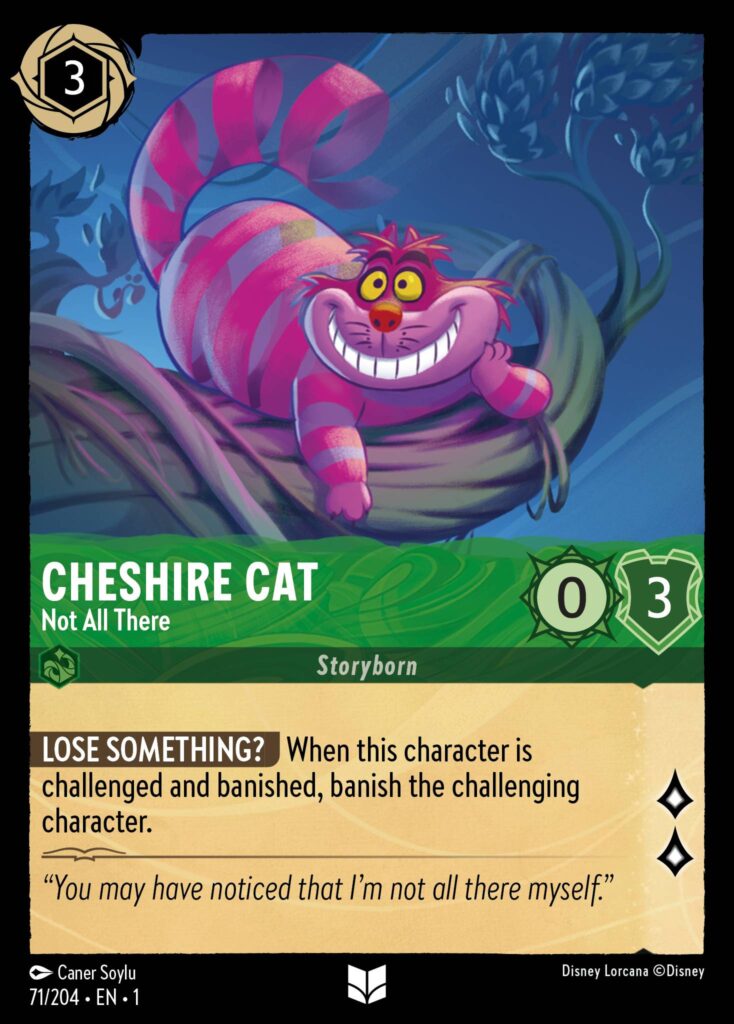
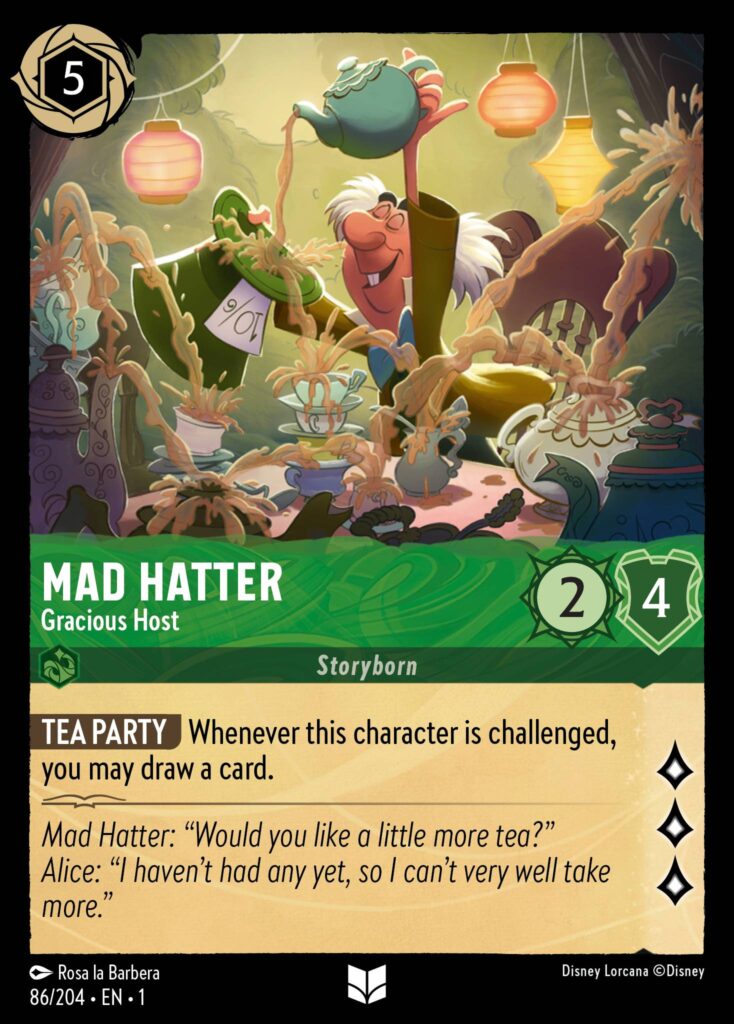
Moving on, one of emerald’s best qualities is the challenge effects many of its characters carry. Emerald is the only ink with characters who actively punish opposing players for challenging them. Take cards like Flynn Rider, Charming Rogue; Kuzco, Temperamental Emperor; and Cheshire Cat, Not All There for example. Each one has a strong questing value that forces opponent’s to challenge or risk falling behind, and then once challenged and/or banished, their effects activate – drawing you cards, forcing opponents to discard or return a character to their hand, and more. These types of characters naturally lean into a more aggressive shell, and pair well with amber and amethyst.
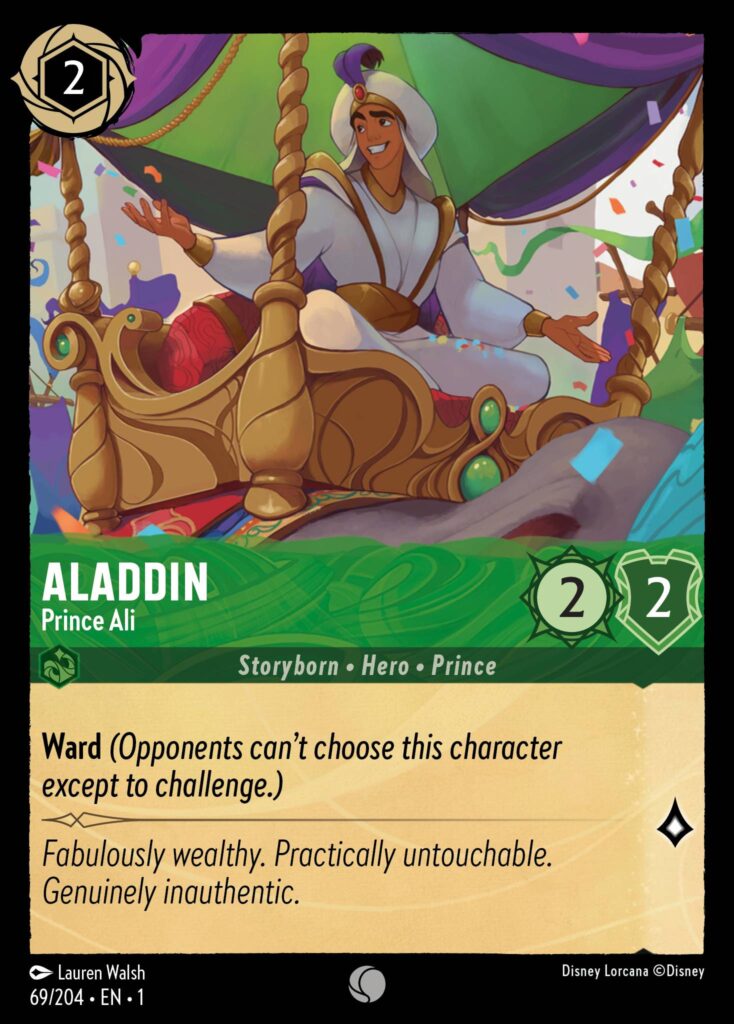
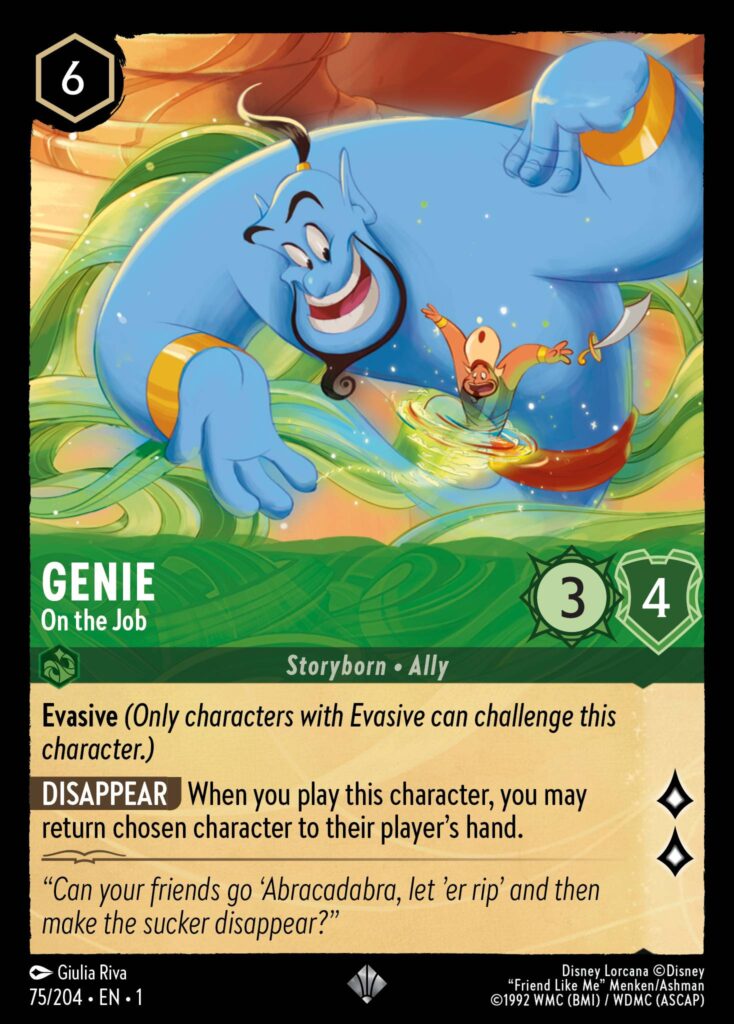
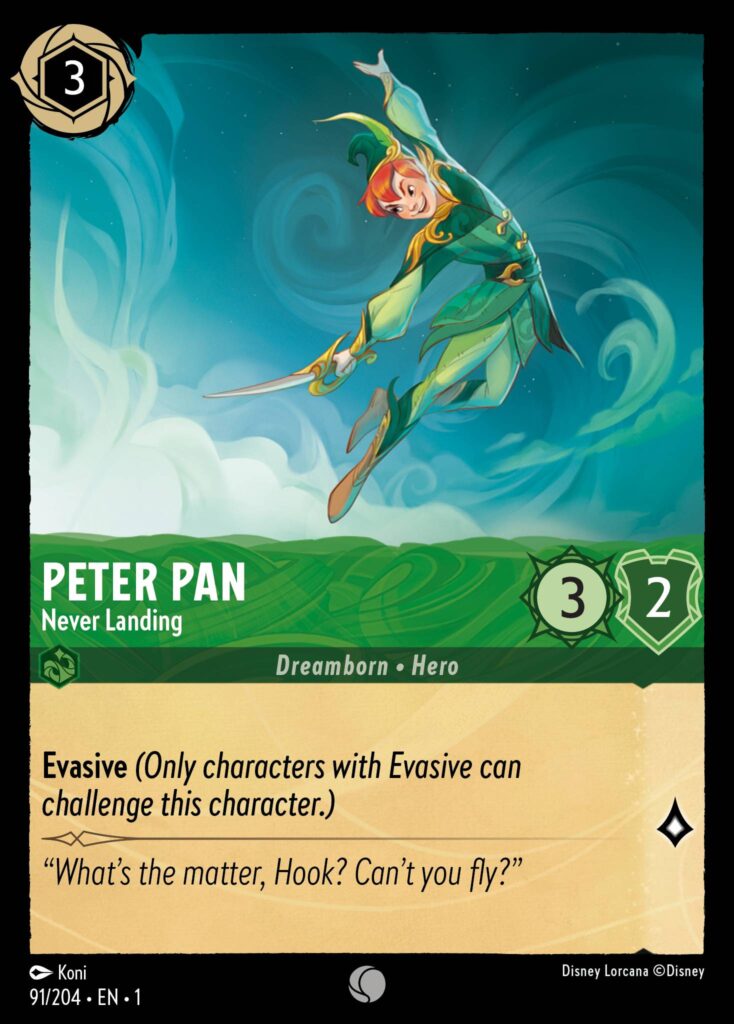
Emerald characters also tend to have keywords like ward and evasive, which make interaction through actions or challenges a nightmare for opponents. Players looking to build a dedicated evasive deck will want to pair with ruby or steel to fill out the deck and cover emerald’s natural weak spots.
Popular Decklists
Amber/Emerald Aggro – by LorcanaDecklists
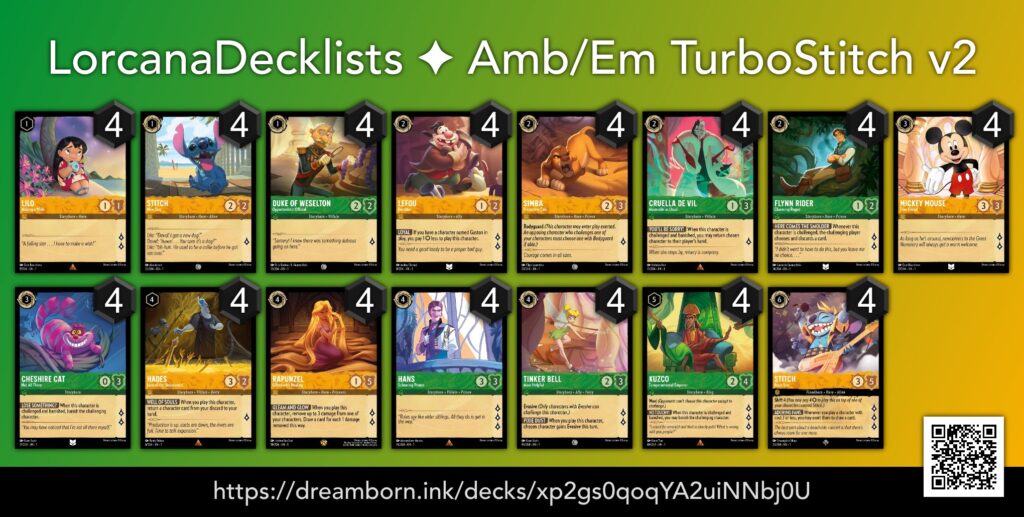
Ruby/Emerald Evasive (Budget) – by Lorcana Decklists
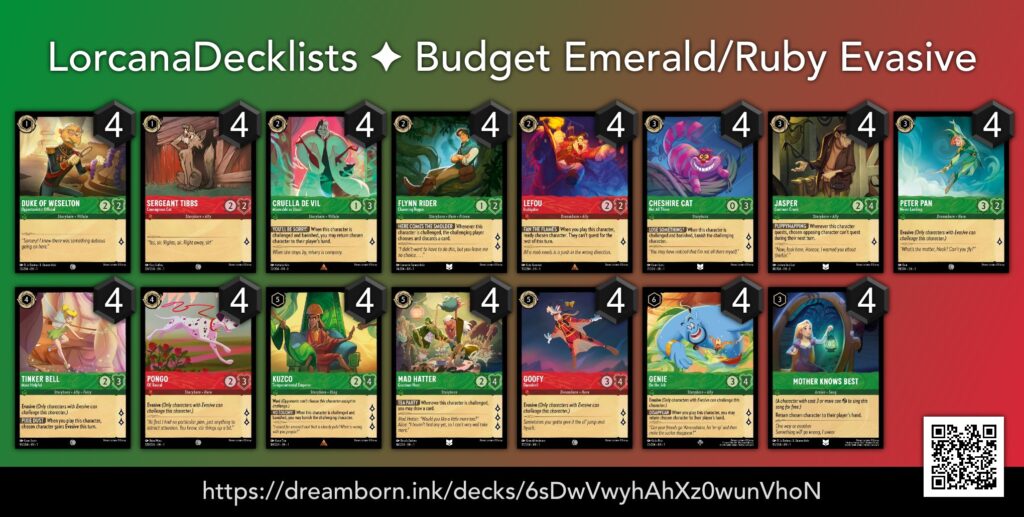
Ruby
Ruby glimmers are daring. They use their speed and bravery to defy the odds. They are often warriors, explorers, and daredevils.
Ravensburger
Key Cards
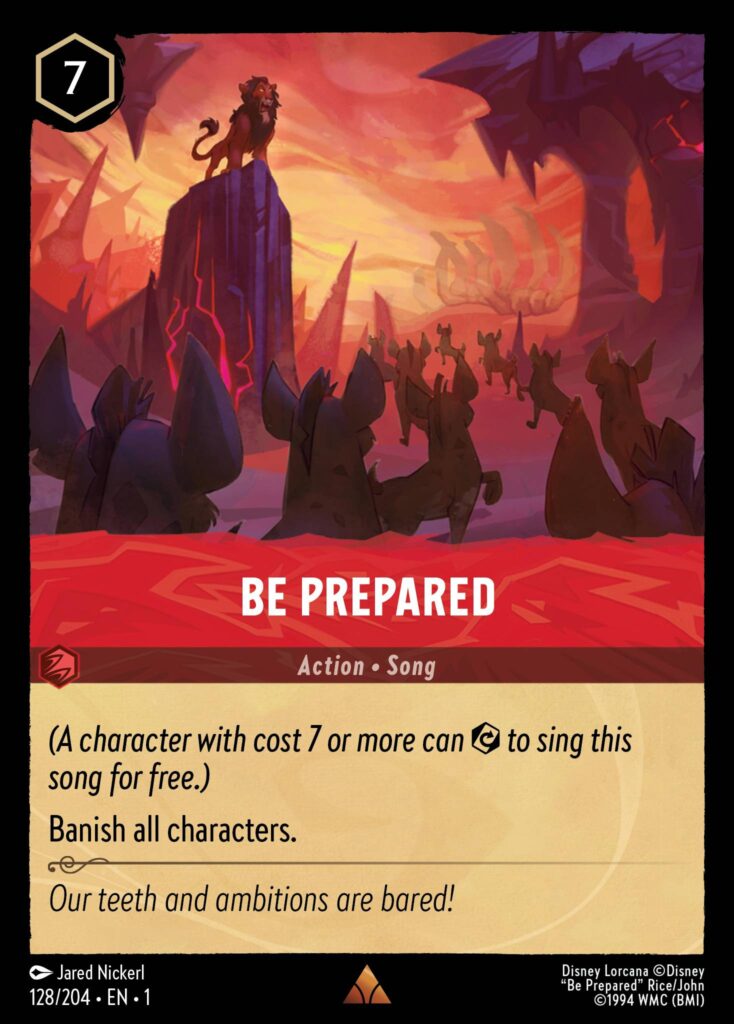
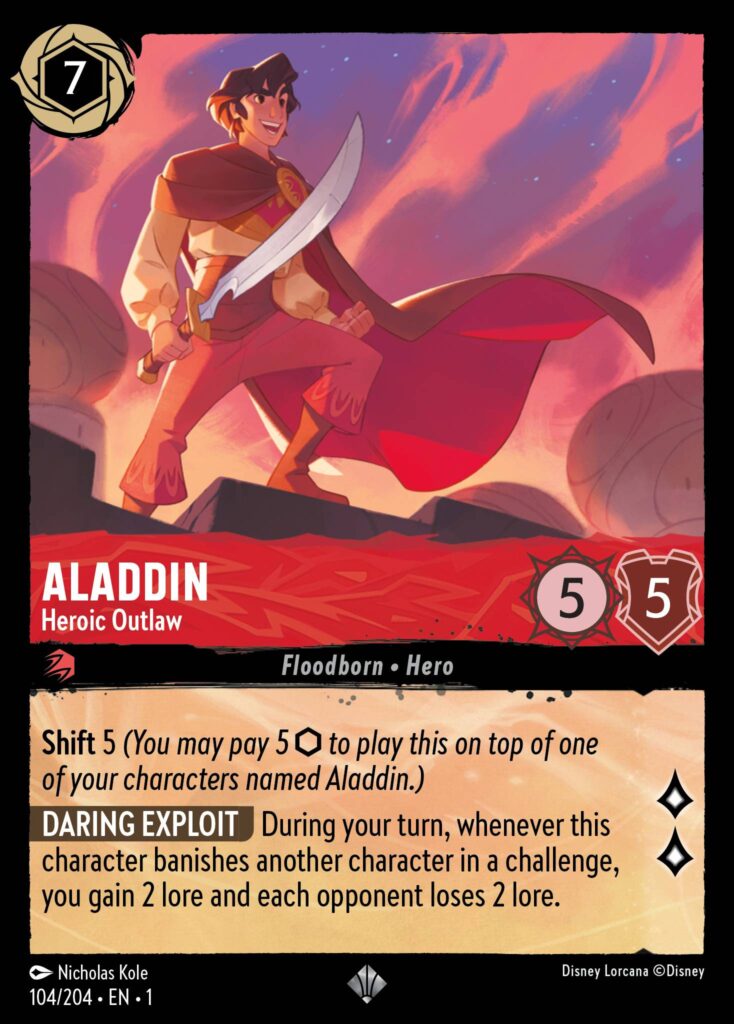
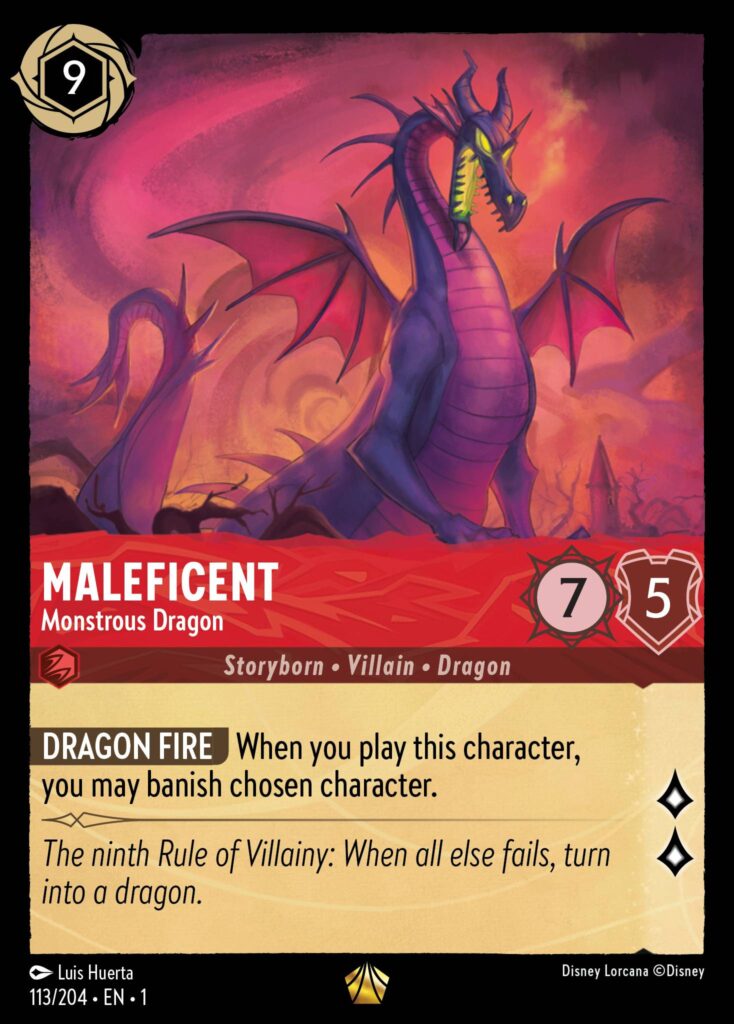
Key Mechanics
- Rush
- Reckless
- Evasive
Main Themes
- Character interaction
- Lore drain
Ruby is the runner-up for the strongest ink in The First Chapter, second only to amethyst in a very close race. Ruby has the highest density of cards that interact directly with opposing characters, making it a great choice for controlling the flow games and a perfect complement to amethyst.
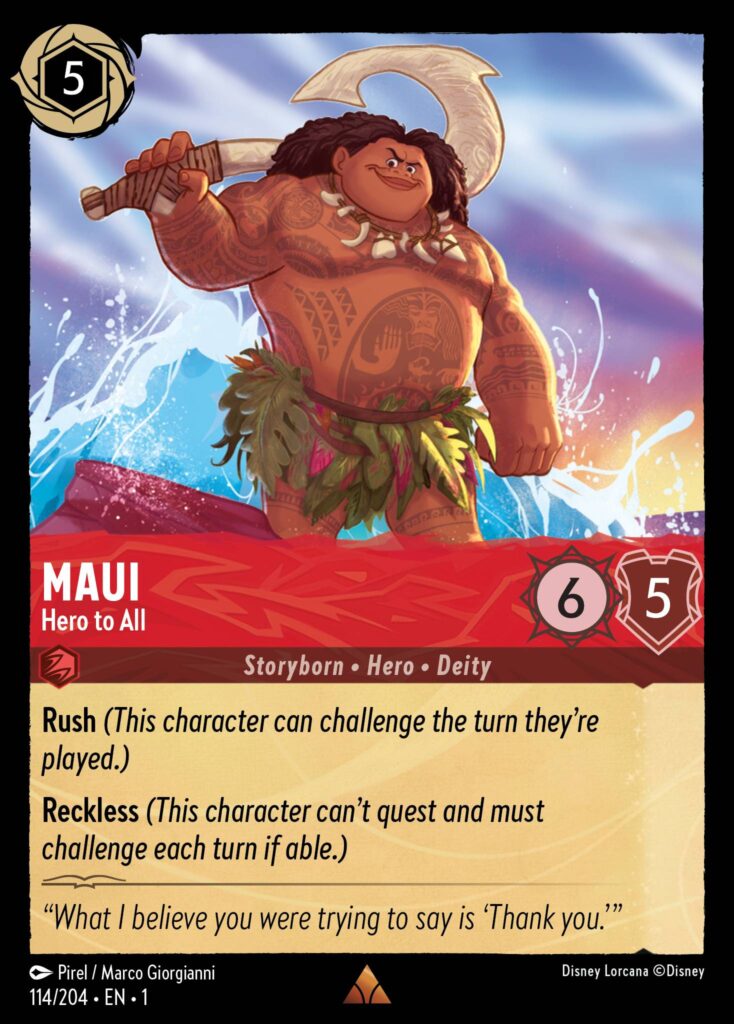
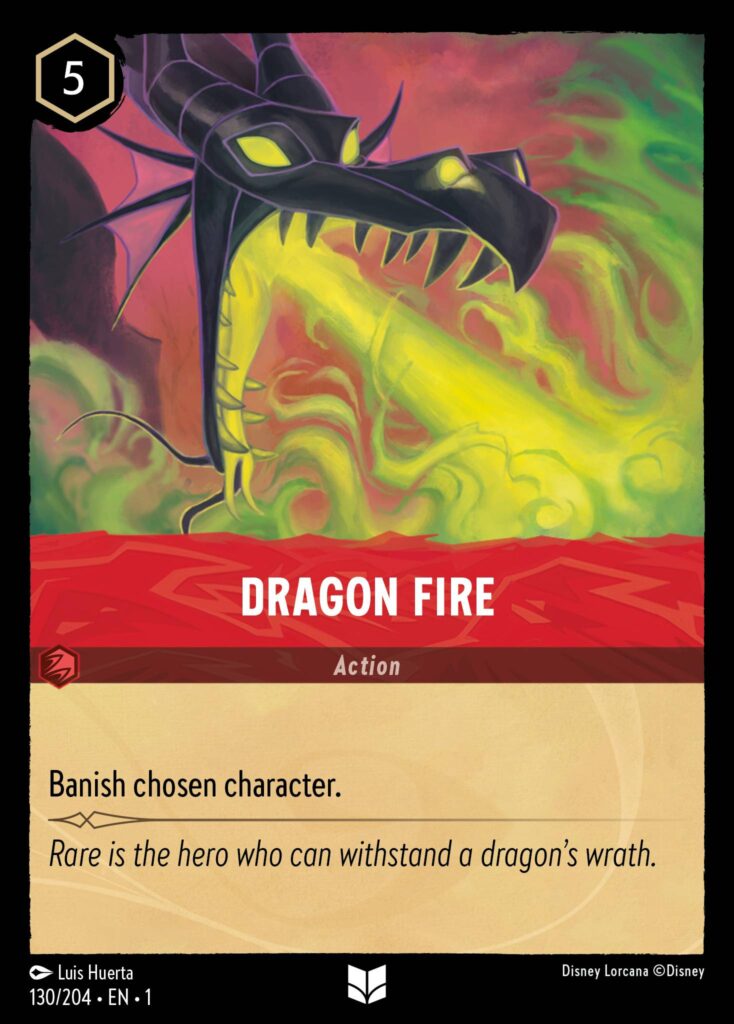
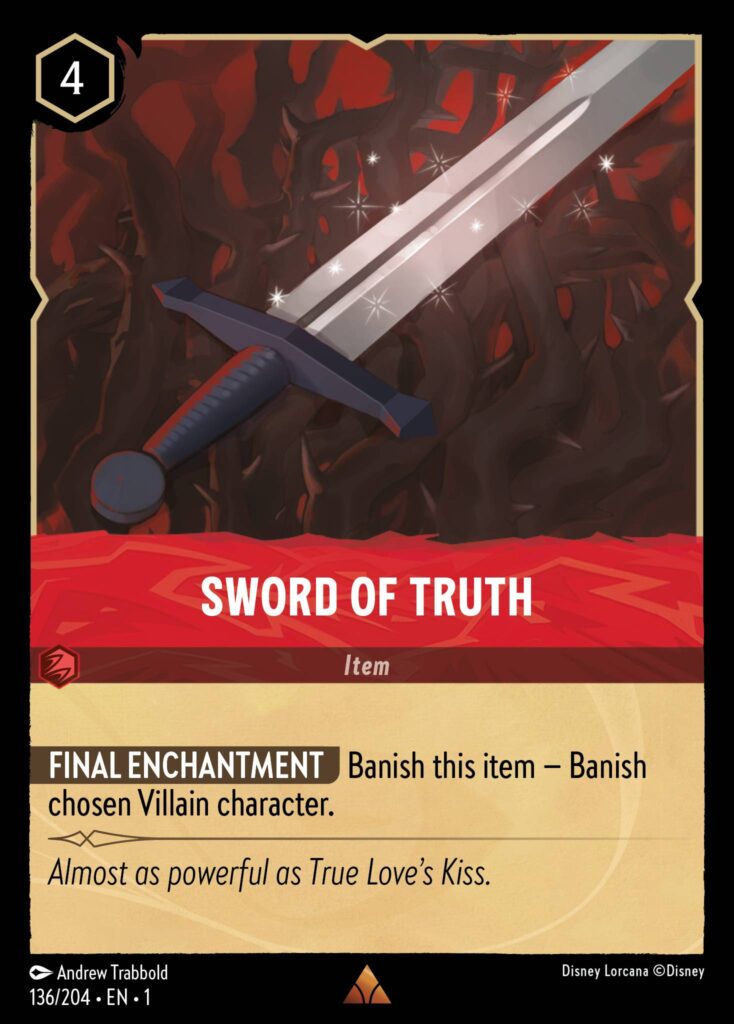
Many of ruby’s characters have rush, reckless, or a combination of the two. Rush allows a character to challenge the turn they are played, turning them into removal with a body that can stick around for more. If a character has reckless, they won’t have any lore value, meaning they cannot quest, and instead must challenge each turn if able. This trade off may seem harsh, but it’s almost always worth it, especially on cards like Maui, Hero to All and Gaston, Arrogant Hunter.
Continuing the trend of good removal, ruby gets access to Lorcana’s best and only unrestricted banishing action — Dragon Fire. This card is only an uncommon, but it feels legendary. Dealing with any character (barring those with ward) for five ink is a steal, and you’ll be hard pressed to find a ruby deck without four copies. Moving up the curve just slightly, we have the only hard sweeper currently in the game — Be Prepared. Not only is this song a classic, but it’s also the glue that holds Lorcana’s best deck together. Chances are, if you’re resolving one or more copies of this powerful song, you’re going to win the game.
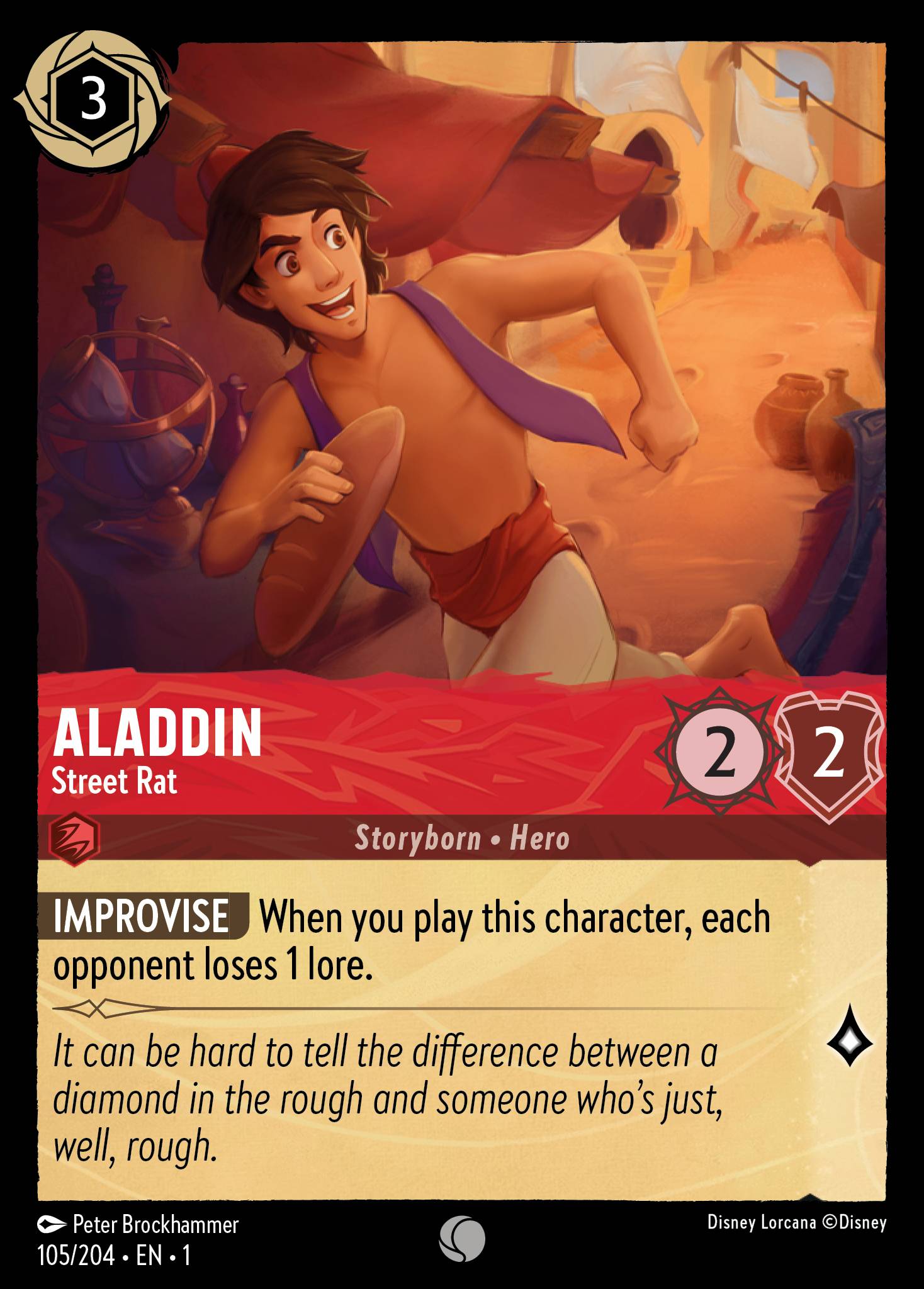
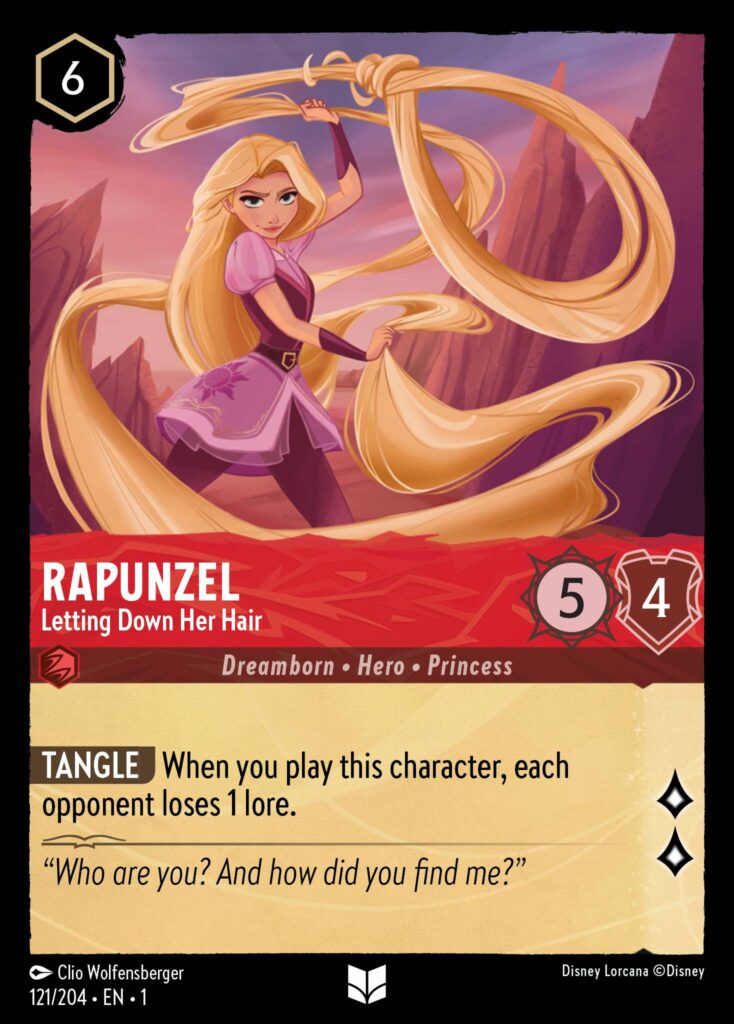
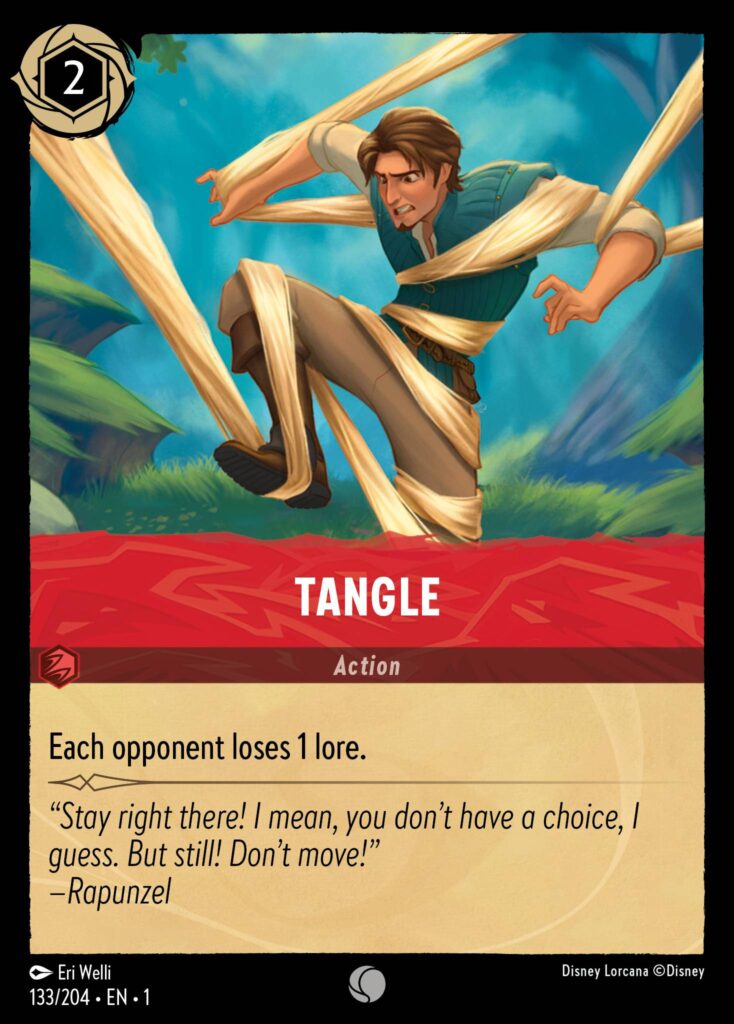
The last main theme for ruby is lore drain. There are very few cards currently in Lorcana that interact with your opponent’s lore count, but the majority are in ruby. While Rapunzel, Letting Down Her Hair and Tangle are both fairly underwhelming, Aladdin, Street Rat is a decent three-drop that drains for one lore, but more importantly, can be used to shift into Aladdin, Heroic Outlaw. This super rare Aladdin is one of ruby’s marquee cards – providing a strong body that earns you two lore while draining two from your opponent when banishing an opposing character.
Popular Decks
Ruby/Sapphire Ramp – by ZeroTheHero
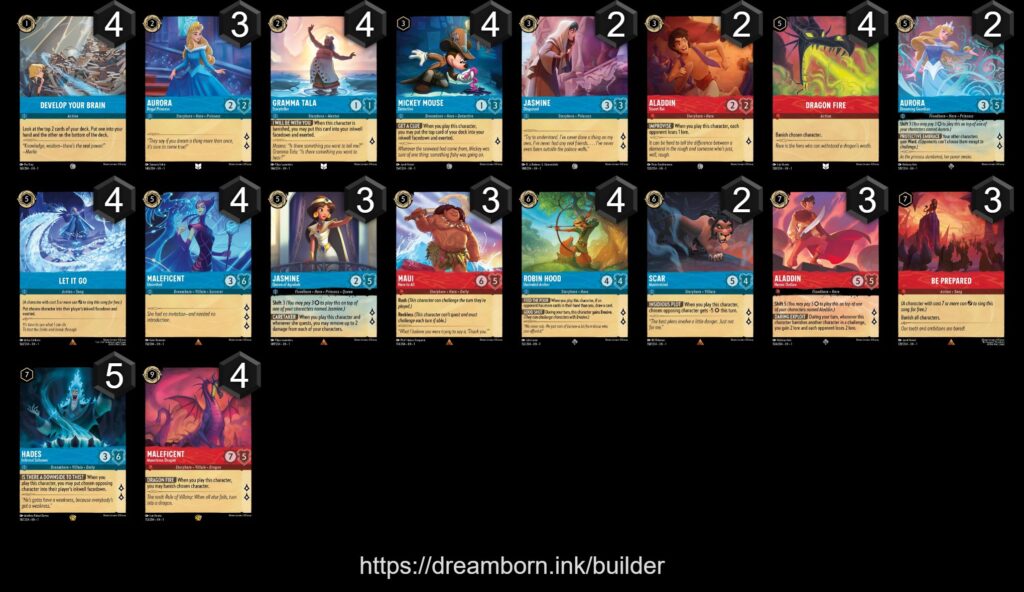
Sapphire
Sapphire glimmers are intellectual. Intelligent and creative, they excel at strategy, invention, and the arts. They can almost always know something, plan something, or invent something that will win the day.
Ravensburger
Key Cards
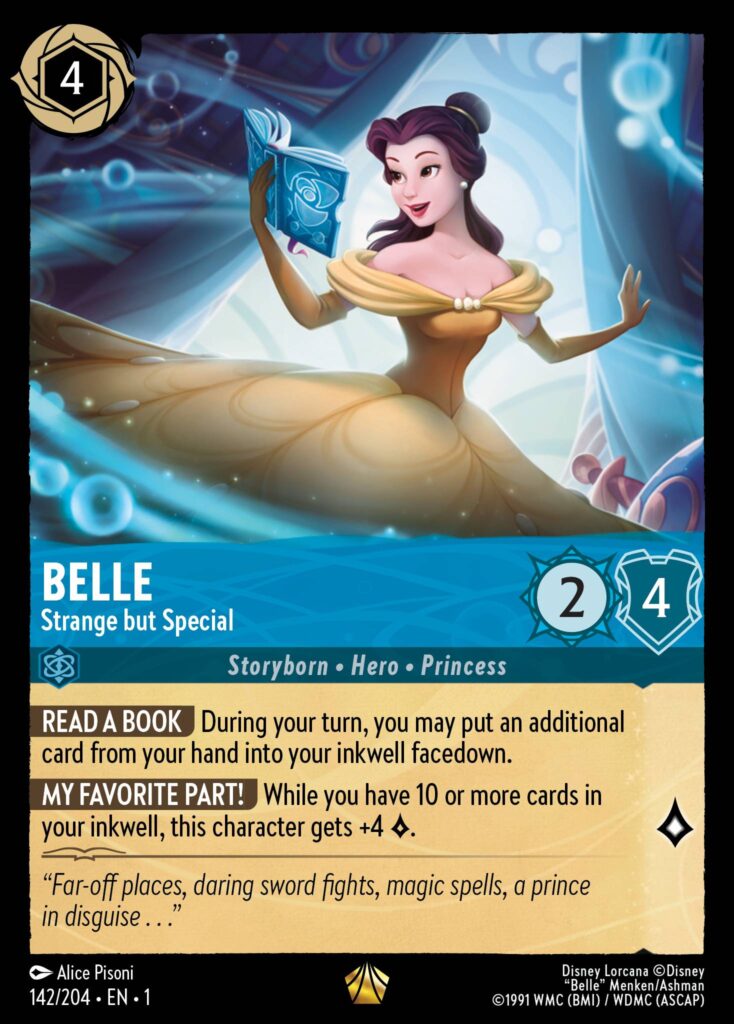
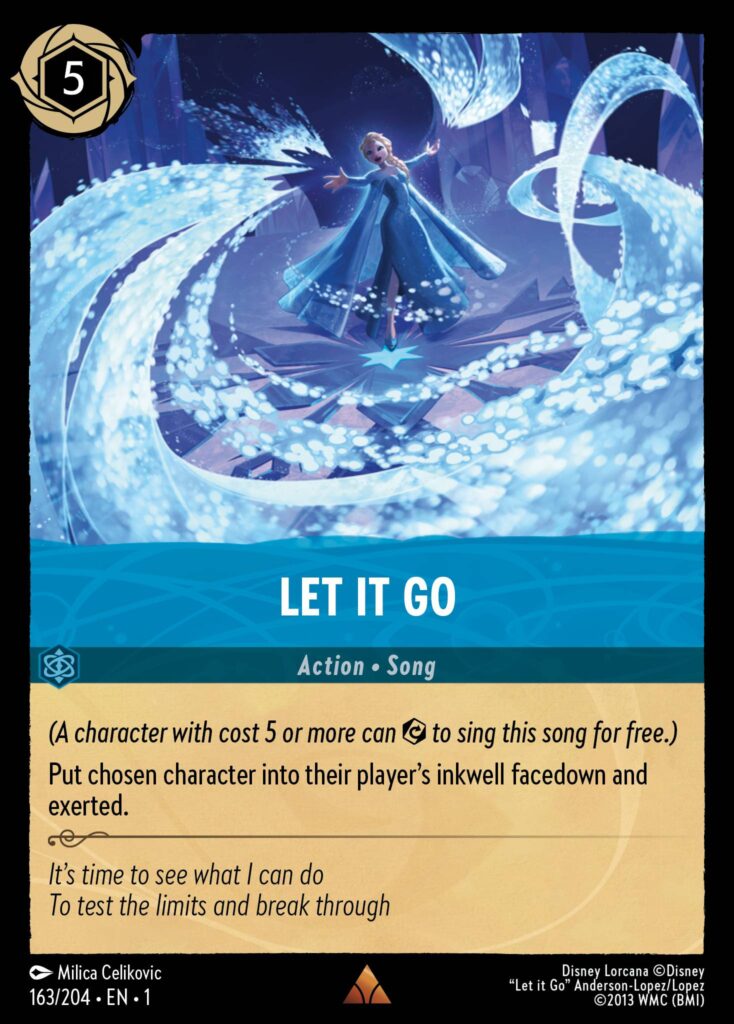
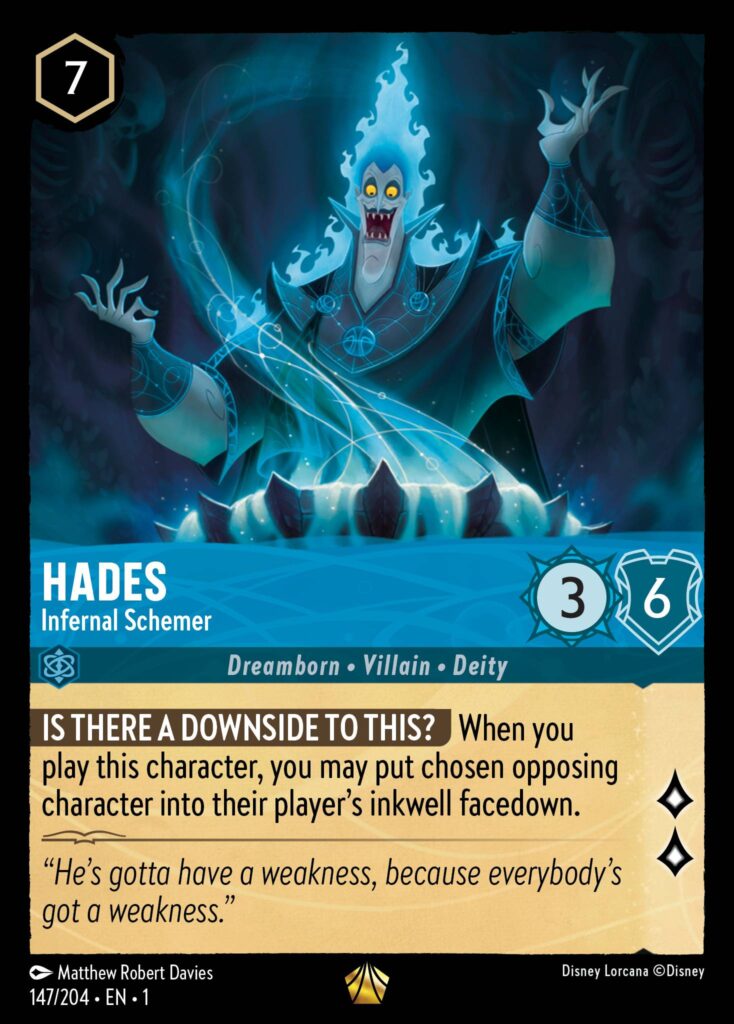
Key Mechanics
- Support
- Shift
Main Themes
- Inkwell acceleration
- Items matter
Sapphire is one of Lorcana’s most unusual inks, and one that I picked to be the strongest prior to release. My prediction may have missed the mark, but it wasn’t by much, as sapphire lands itself in the Top 3, just behind amethyst and ruby.
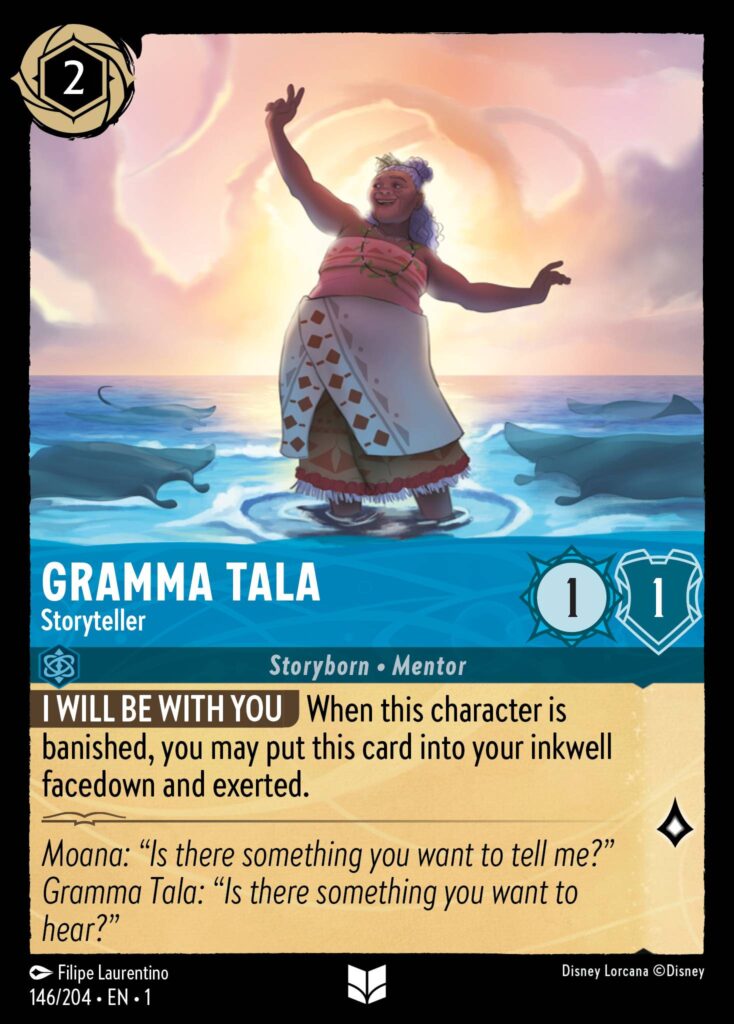
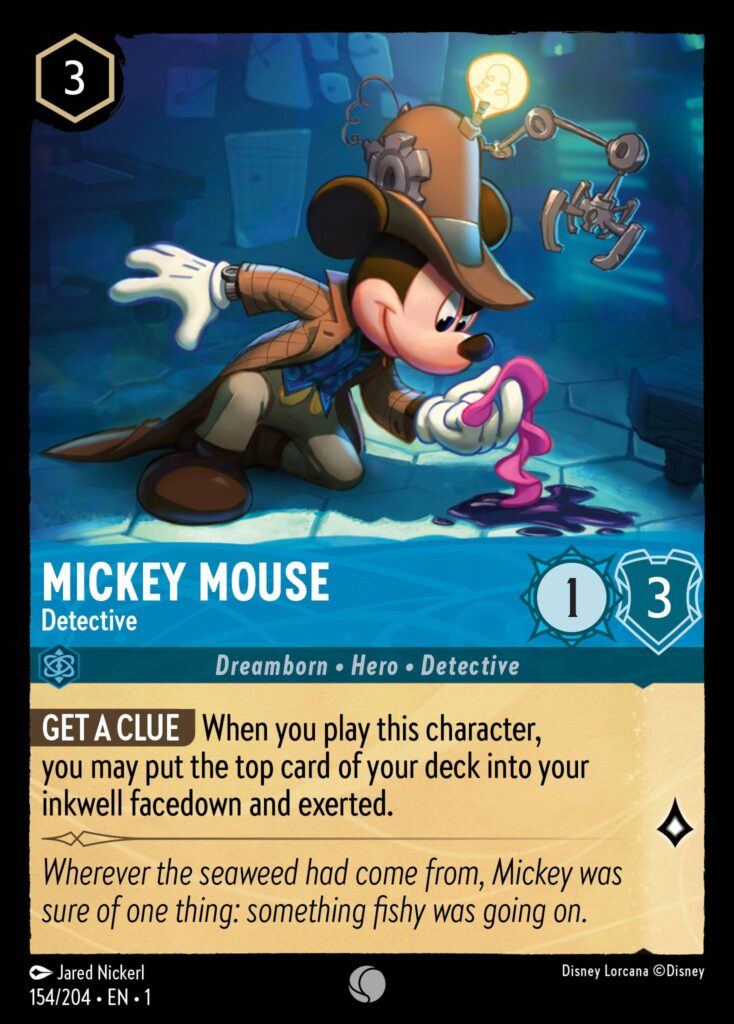
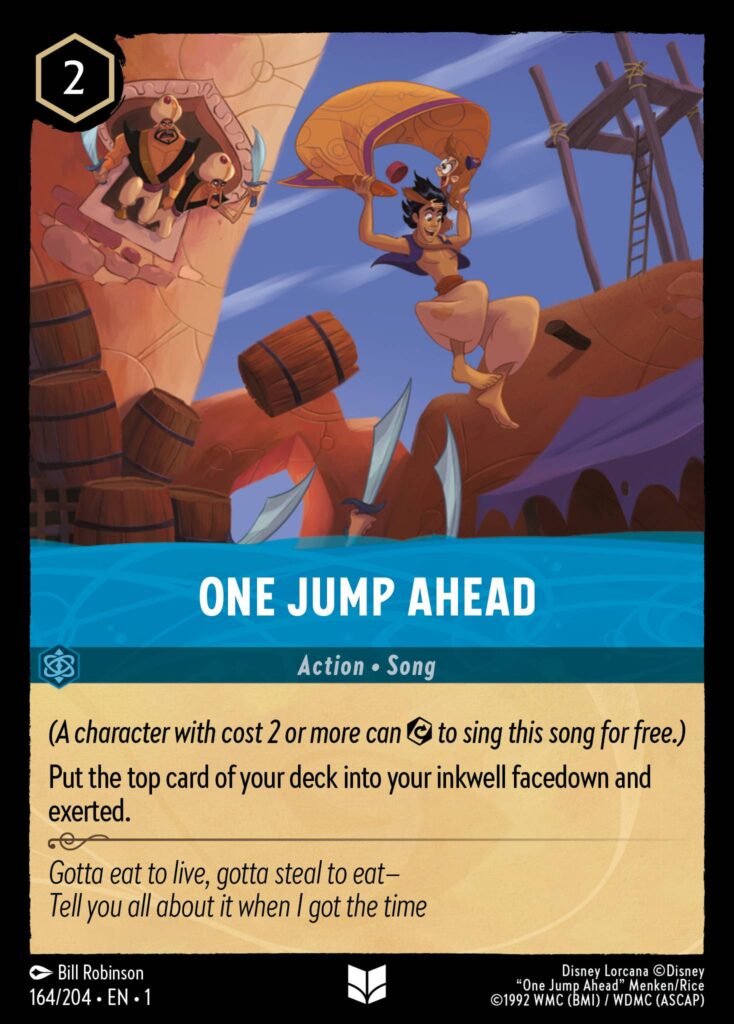
The main theme of sapphire is inkwell acceleration – also known as colloquially as “ramp”. This theme appears only in sapphire, and allows you to add ink to your inkwell at a rate beyond the normal one per turn. Cards like Mickey Mouse, Detective and One Jump Ahead are the key to sapphire’s ramp strategy, as they immediately put a card from the top of your deck into your inkwell (you don’t get to see what it is and it doesn’t matter if the card is “inkable”). You’ll then look to capitalize on your extra ink by playing expensive cards ahead of curve.
Sapphire has two key cards that act as payoffs for your extra ink: Belle, Strange but Special and Hades, Infernal Schemer. While Belle is a major payoff, she’s also an integral part of sapphire’s ramp strategy – allowing you to play an additional card from your hand into your inkwell once per turn. When you hit 10 total ink in your inkwell, Belle gains plus four to her questing value for a total of five – currently the highest individual value in the game. Hades is a more straightforward payoff that removes a character from play by putting it into their controller’s inkwell, and then sticks around after to quest and challenge.
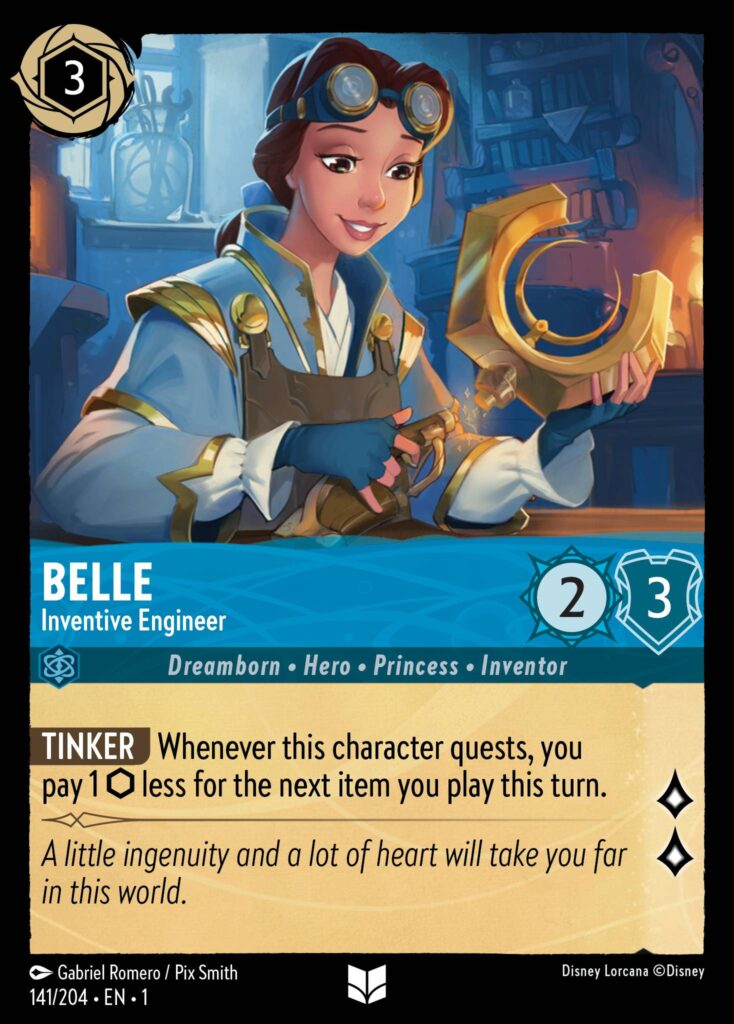
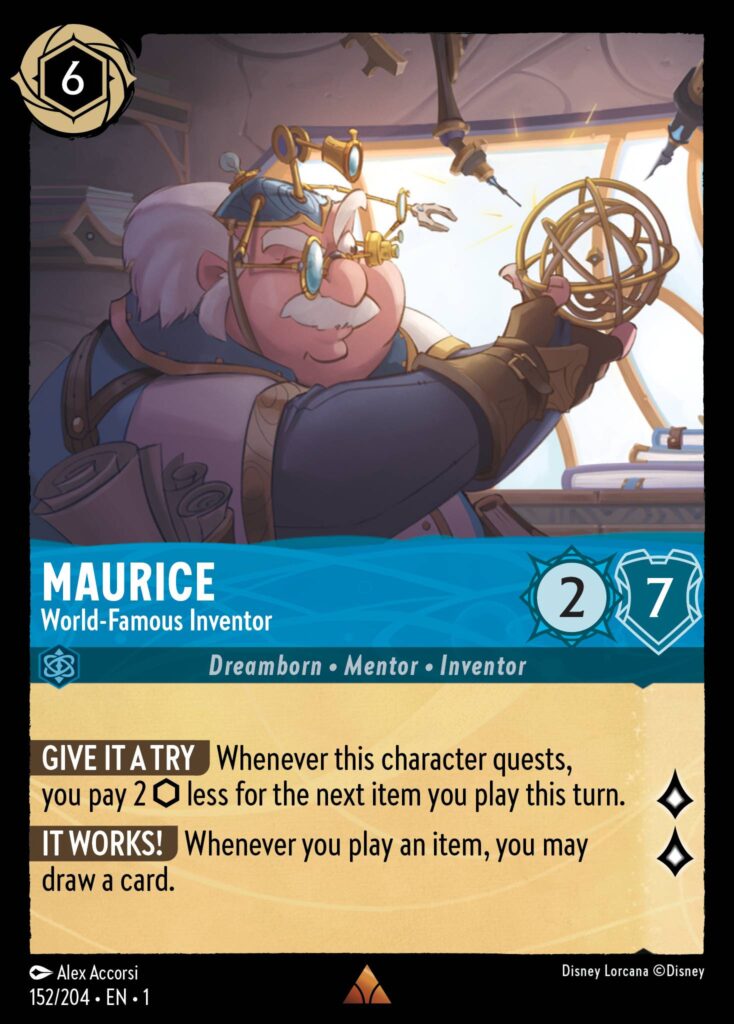
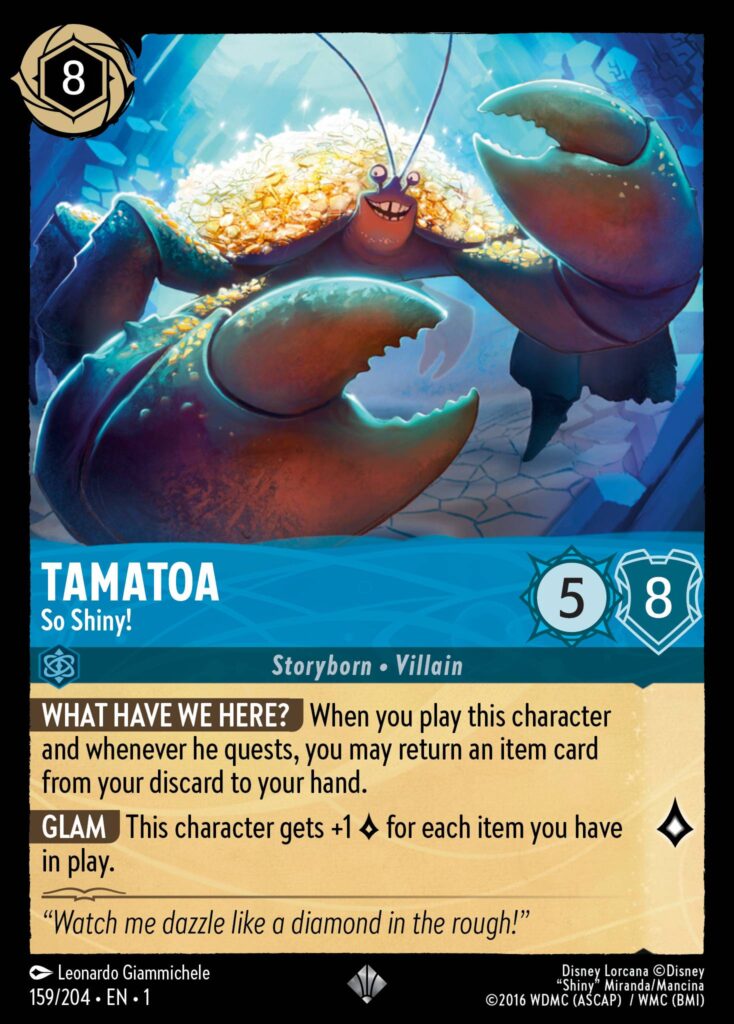
Sapphire’s secondary theme is items matter. There are several cards in this ink that synergize with items by reducing their costs, returning them from your discard pile to your hand, drawing cards, and more. There are only 20 total items in The First Chapter however, and Tamatoa, So Shiny! is currently the only major payoff for item decks. This is one of the strategies that I foresee growing stronger with each new set release, but doesn’t quite make the cut for competitive gameplay in its current state.
Popular Decklists
Sapphire/Amethyst Ramp – by JamesBaggett91
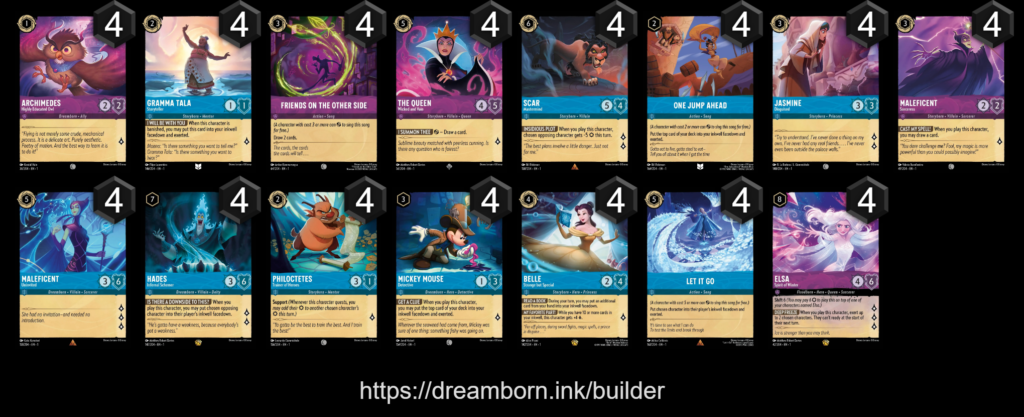
Steel
Steel glimmers are strong. Large and imposing, armored, or just plain powerful, Steel glimmers can apply huge amounts of brute force to get the job done.
Ravensburger
Key Cards
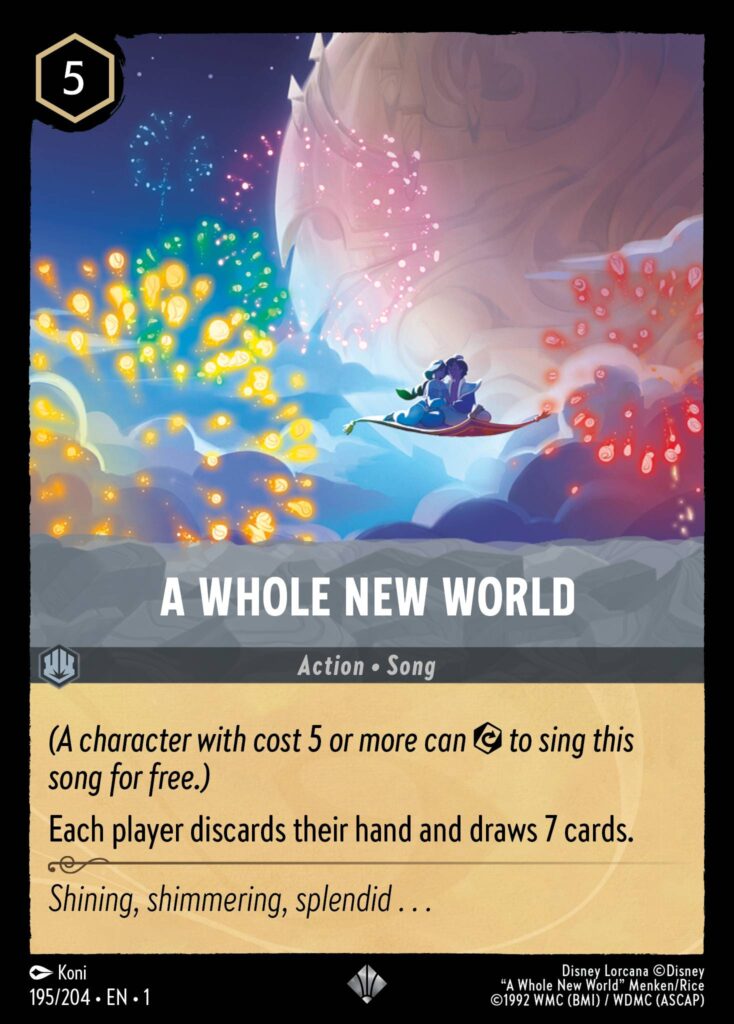
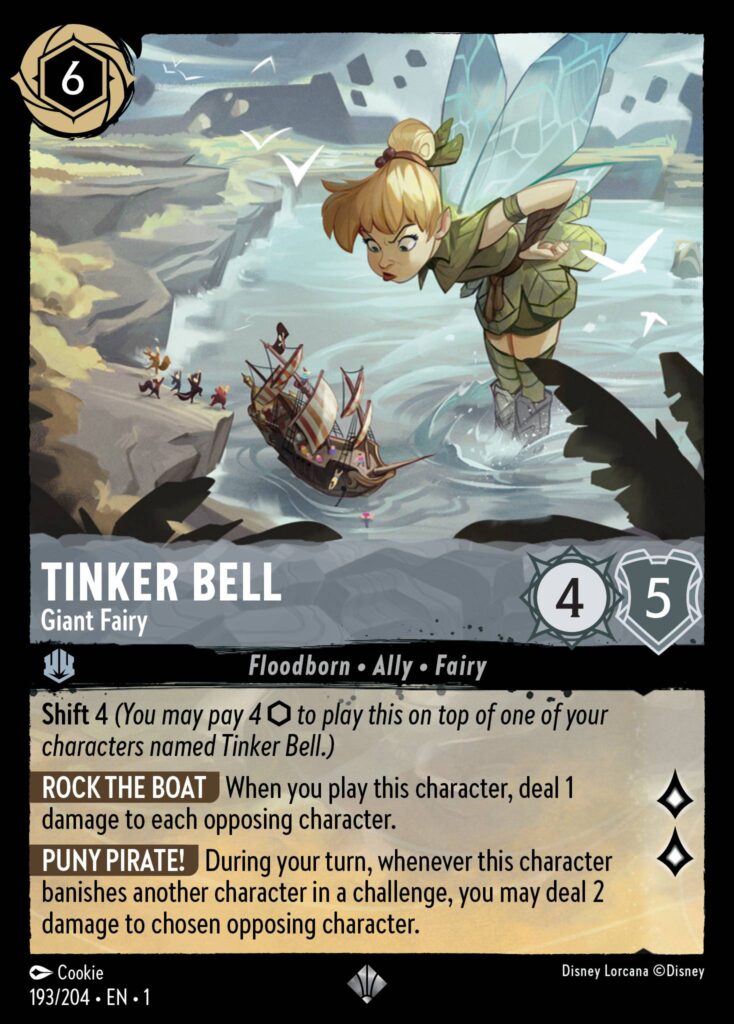
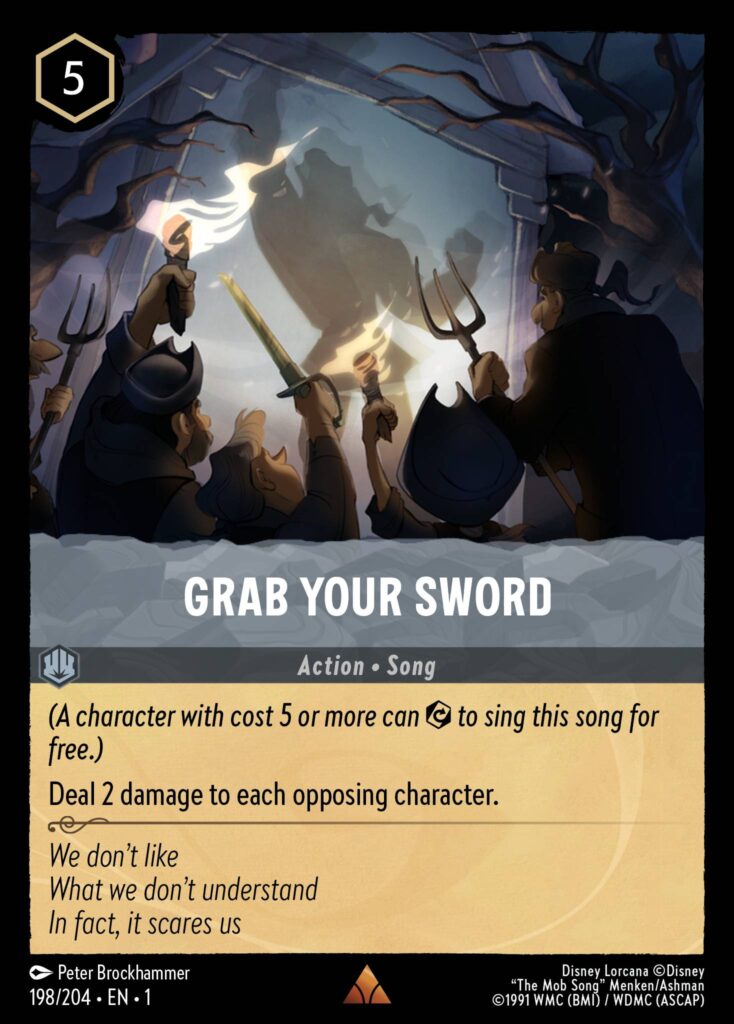
Key Mechanics
- Shift
- Bodyguard
- Challenger
Main Themes
- Damage-based removal
- Item destruction
- Bodyguard/Musketeers
- Deckout
With tons of damage-based removal actions and strongly statted characters, steel is a great choice for keeping Lorcana’s more aggressive decks in check.
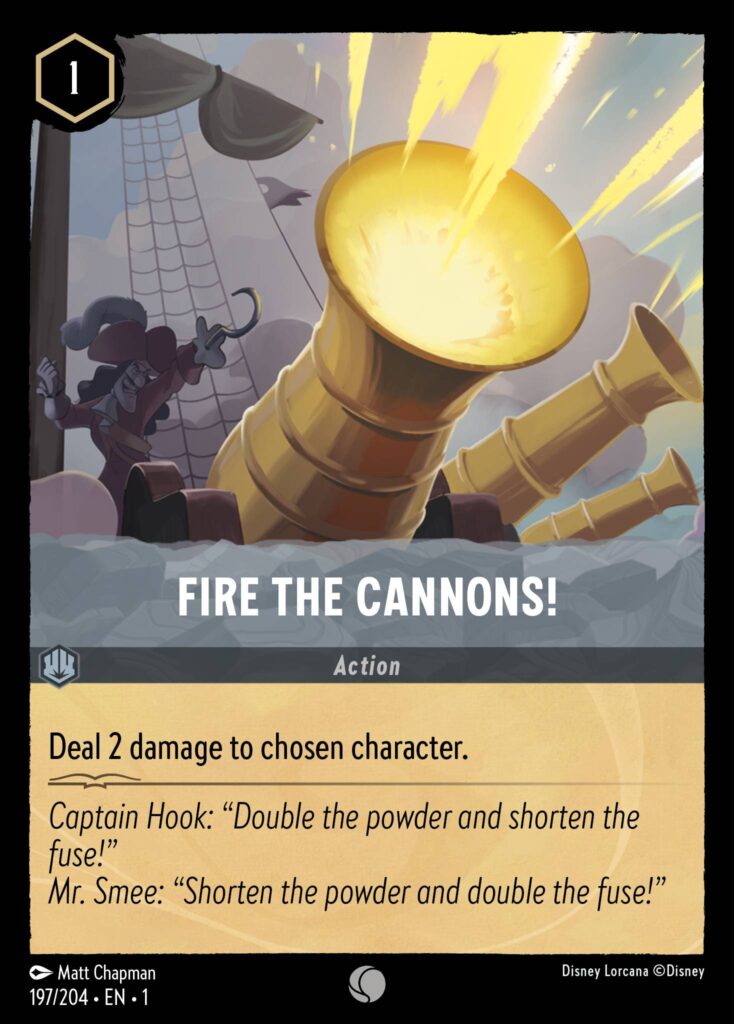
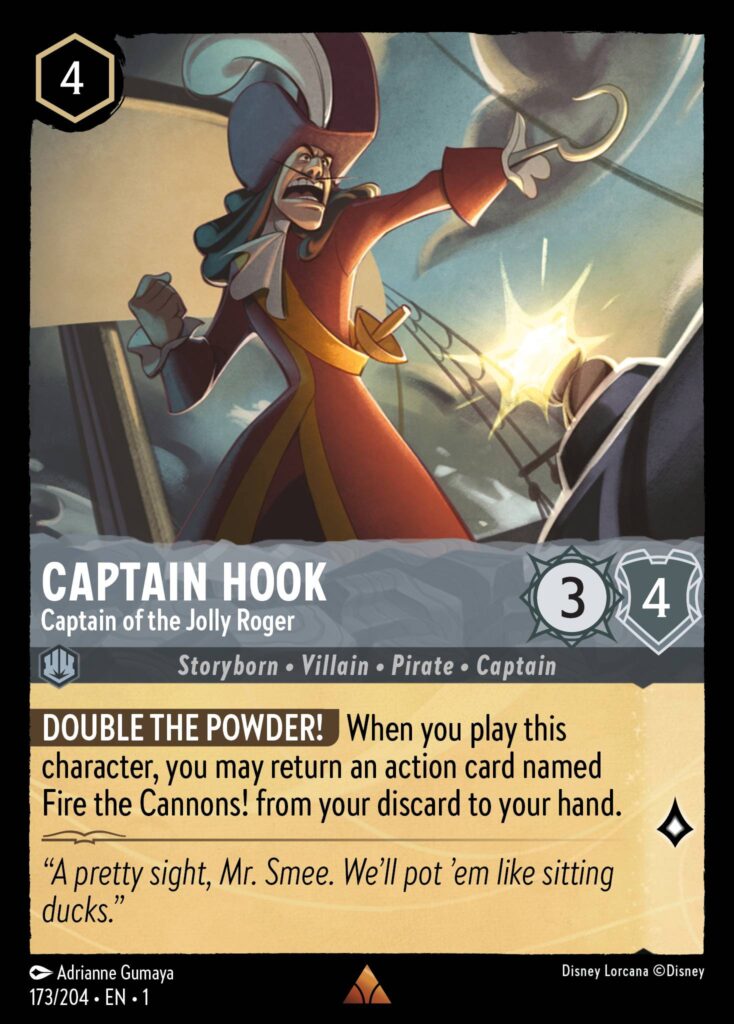
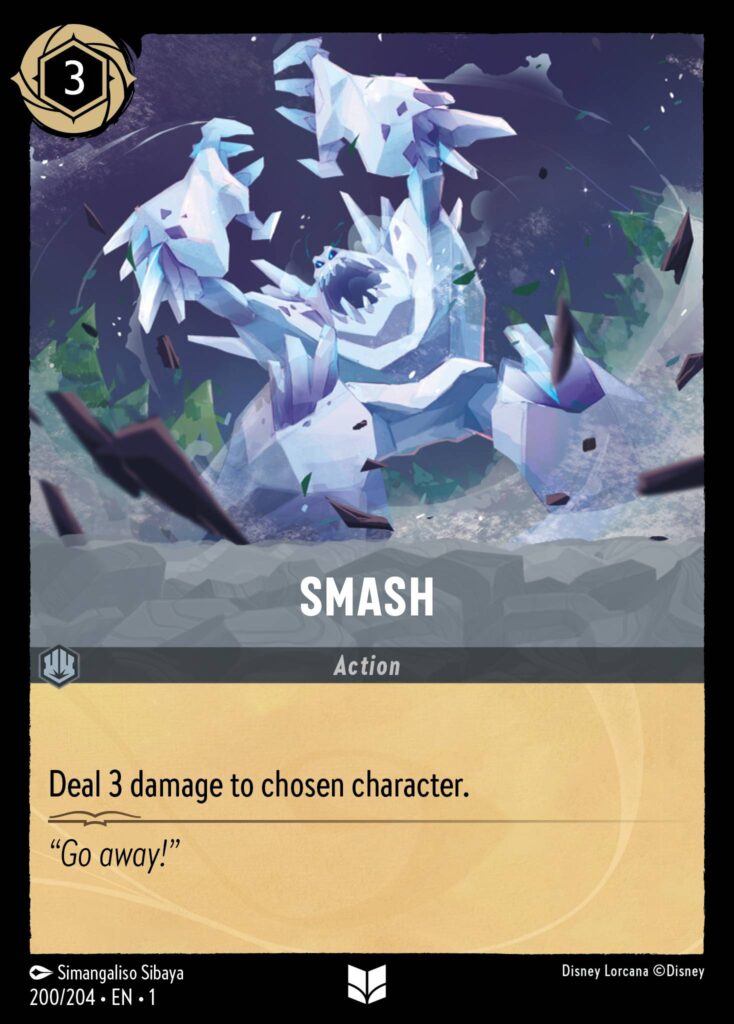
Steel has access to three key damage-dealing actions in The First Chapter: Fire the Cannons, Smash, and Grab Your Sword. Most steel decks will want full playsets of these cards to ensure you draw them, especially in a metagame where you know there are lots of aggressive decks. With the recent rise of ruby/amethyst control, steel has been shaving copies of Fire the Cannons and Grab Your Sword in favor of cards like Beast’s Mirror to try and keep up with the opponent’s card draw. Ultimately, I’ve found steel to be fairly metagame dependent – working well as a supporting ink, but tends to fall flat in the starring role.
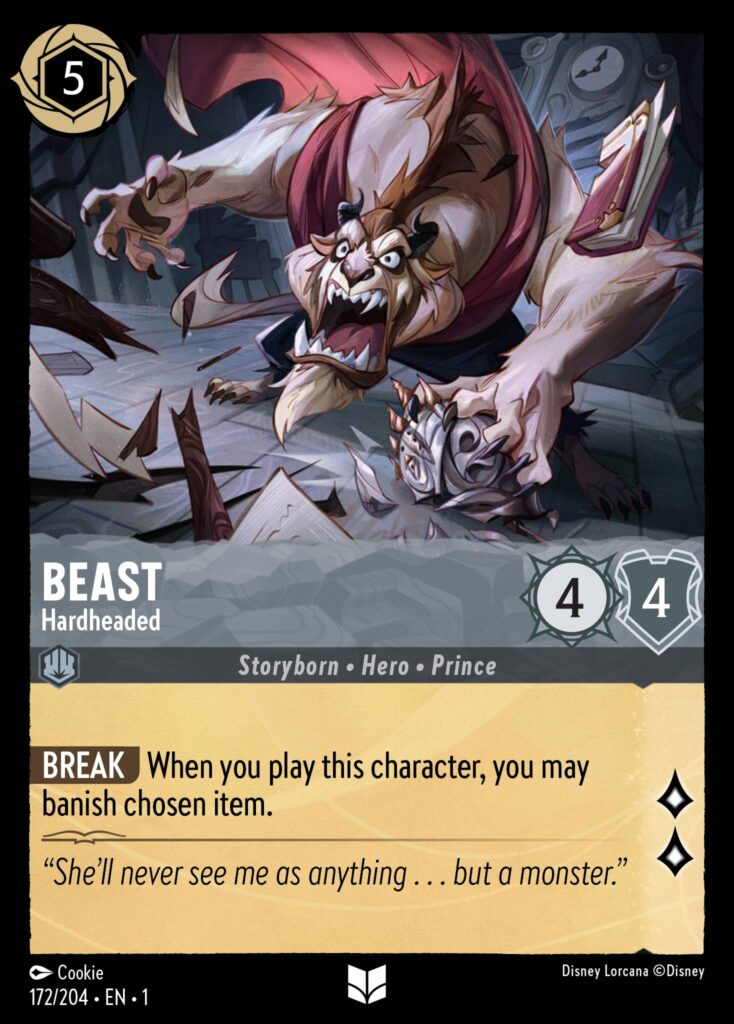
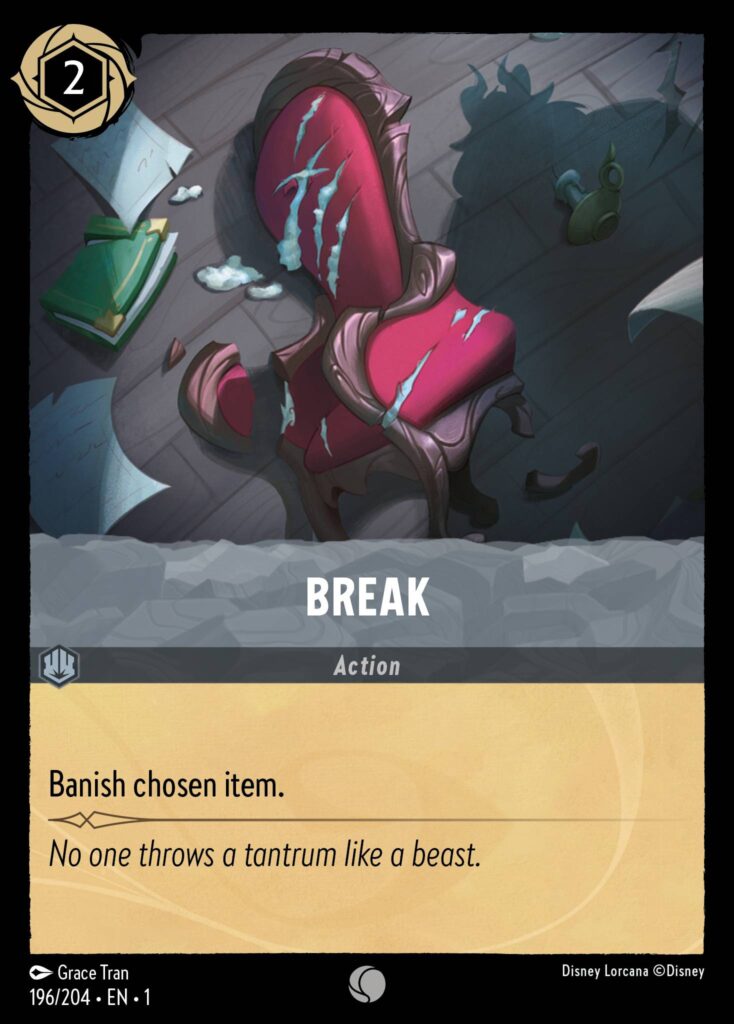
The only direct item destruction in The First Chapter is found in steel. Beast, Hardheaded and Break both deal cleanly with opposing items, and can come in clutch in certain matchups. With only 20 total items across all six inks, Break is too narrow, but Beast is an auto-include, typically as a two-of in most steel decks, since he can take out White Rabbit’s Pocket Watch and Magic Mirror in the amethyst/ruby matchup and leave a 4/4 body behind.
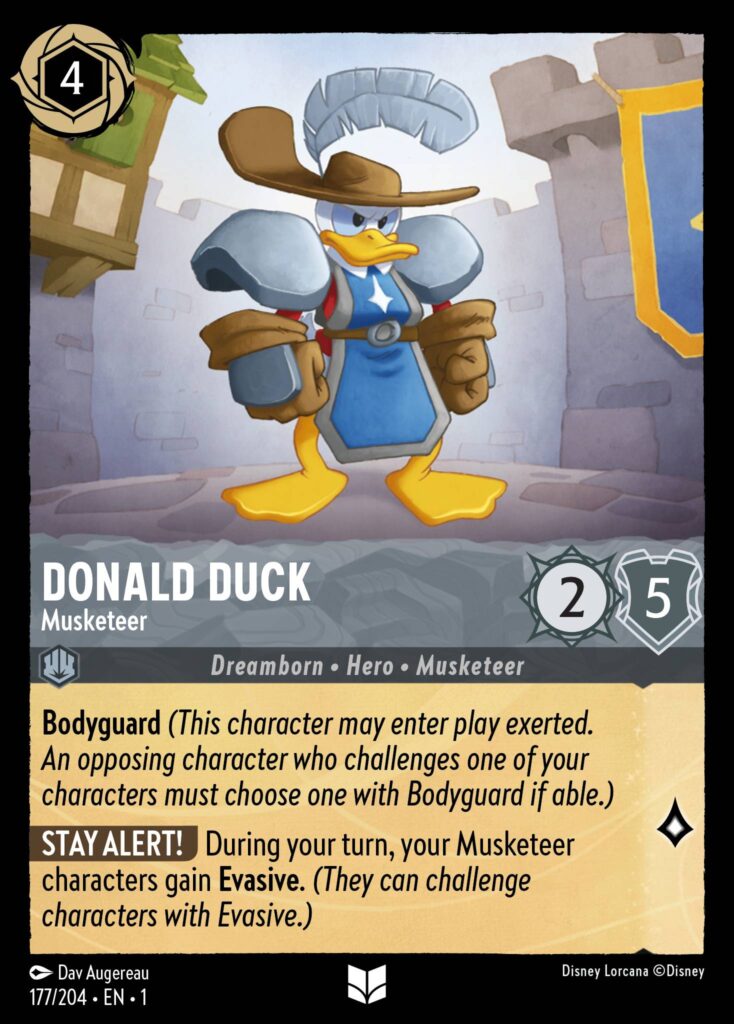
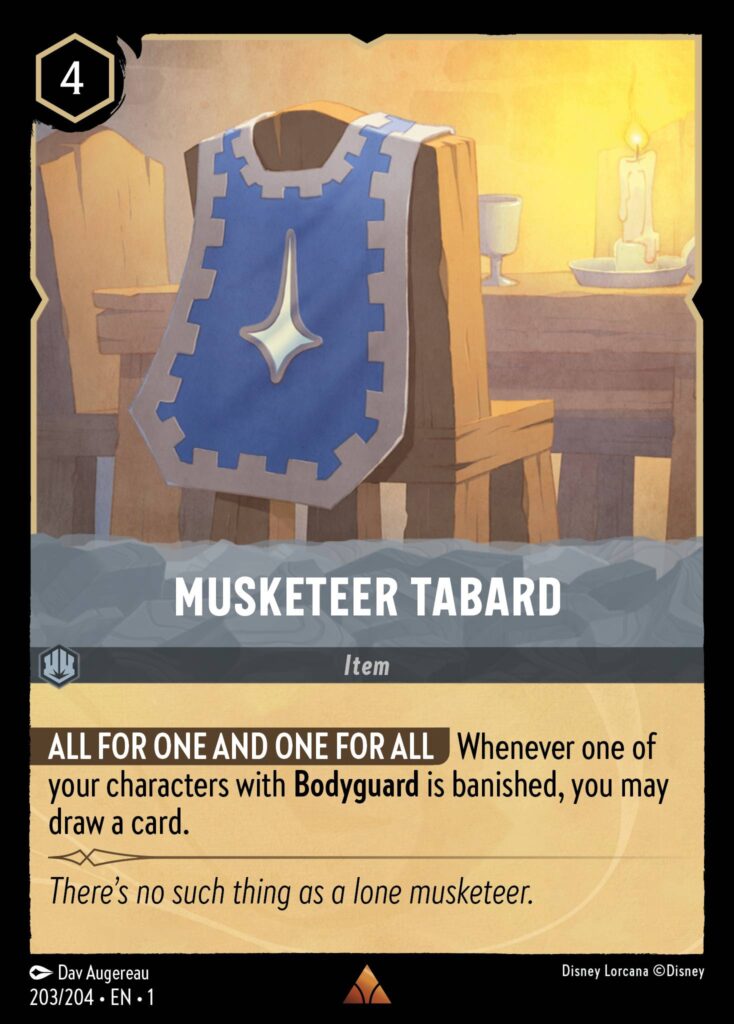
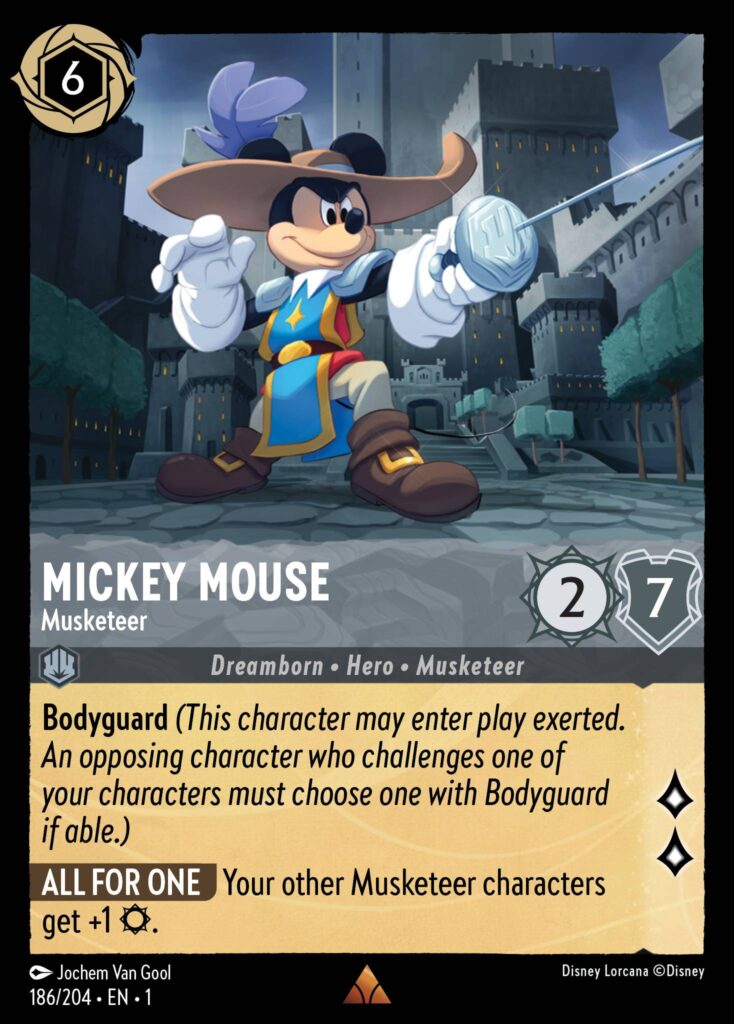
While both bodyguards and Musketeers appear in amber as well, steel gets the nod as the primary ink for a dedicated bodyguard strategy because of Musketeer Tabard. This item is the glue that holds this entire archetype together, and with so little item destruction in The First Chapter, stacking multiple copies can easily run away with games. This is more of a casual, themed deck, but with the right metagame and new supporting cards, it could be a competitor.
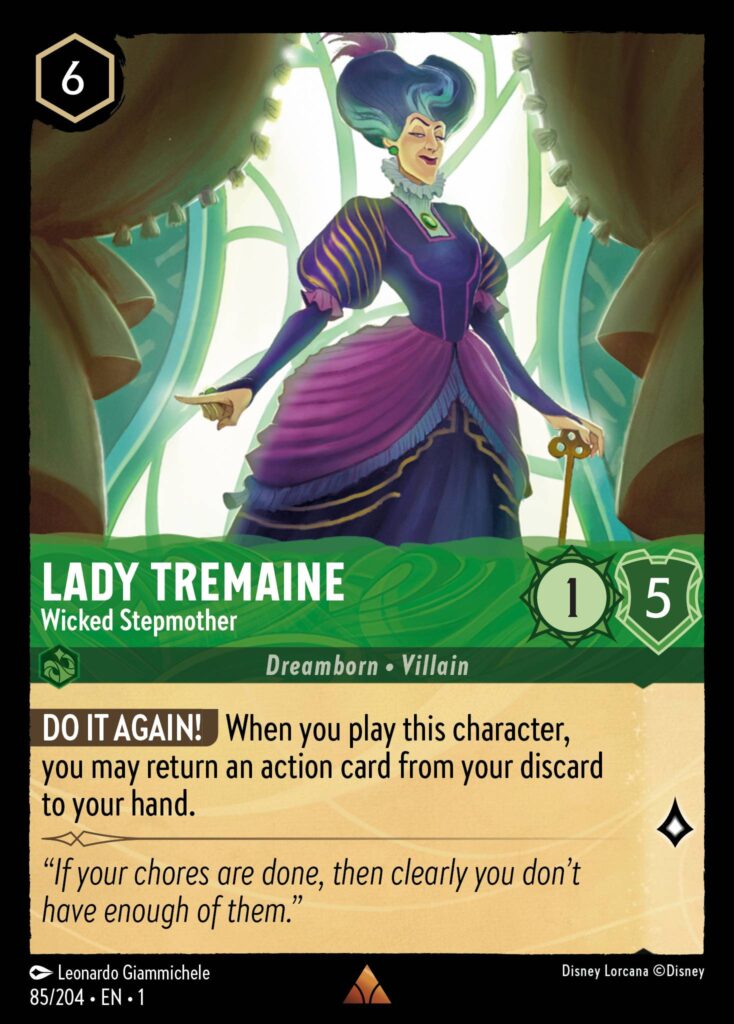
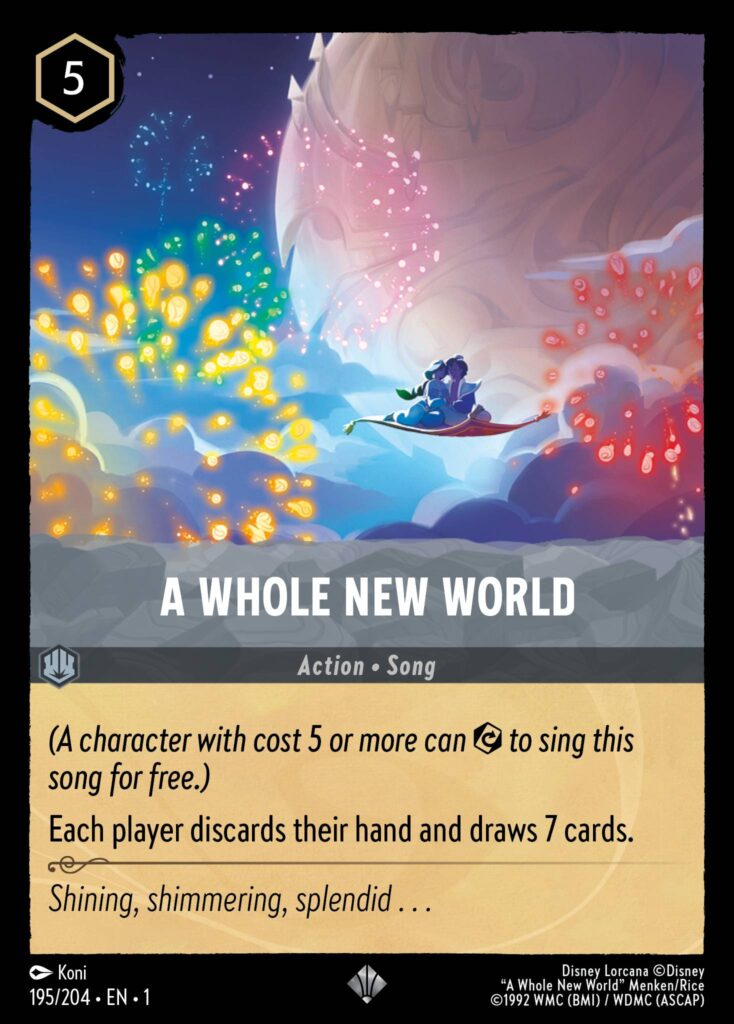
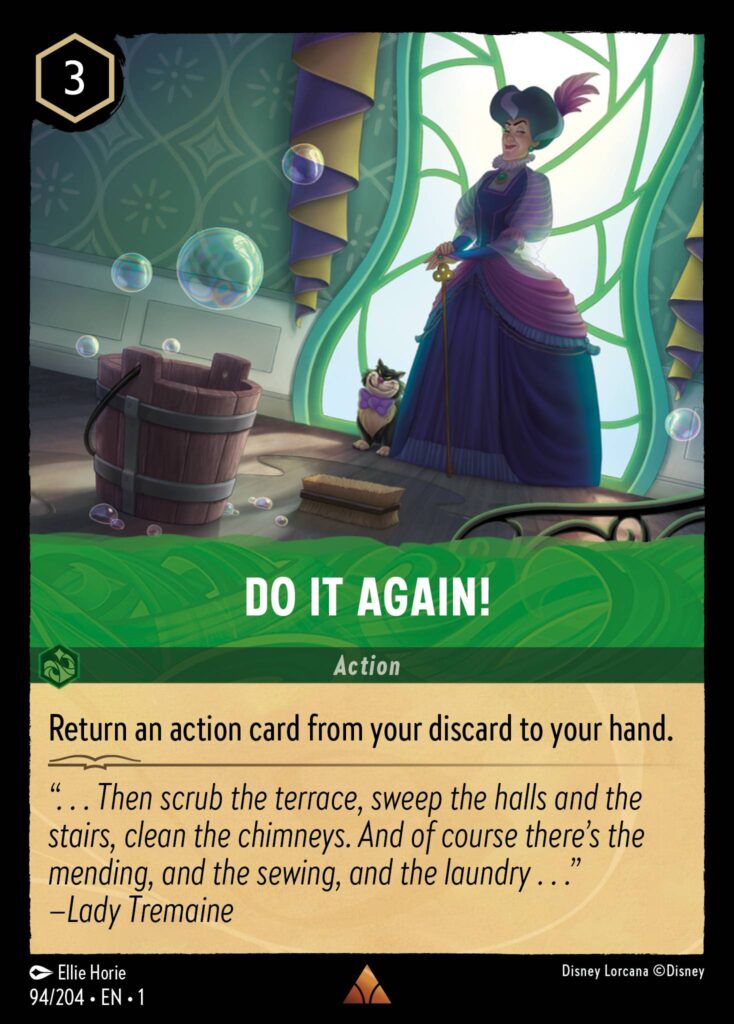
There is one more archetype that steel enables, which I briefly mentioned in the emerald section above — Mill. The term “mill” has been used over the years, across many different trading card games (TCGs) to refer to a strategy that involves winning by running your opponent out of cards in their deck. In most TCGs, milling refers to cards being put from a deck directly into the discard pile. The Lorcana version of mill is slightly different, as you’ll be using A Whole New World (AWNW) to force your opponent to discard their hand and then draw seven fresh cards, but the win condition remains the same.
This strategy requires you to play the full four copies of AWNW, as well as cards like Lady Tremaine, Wicked Stepmother and Do It Again to recycle and cast AWNW. Cards like Genie, Power Unleashed will let you cast AWNW for free later in the game, while providing a body that can keep opposing characters in check. While giving your opponent a whole new hand each turn sounds bad in theory, it actually breaks up their ability to sculpt and plan for future turns.
Lorcana’s mill decks will typically play upwards of 64 cards (over the usual 60) to ensure that you don’t run out of cards before your opponent. When playing this deck, always remember that active player draws their cards first, so if you play AWNW when both you and your opponent have under six cards remaining in deck, you will draw first and ultimately lose.
This strategy is very powerful, but still in development among the tabletop crowd. Time will tell if it can be an actual competitor or go the way of most mill strategies and become a casual pet deck.
Popular Steel Decks
Emerald/Steel Mill – by Steadfast
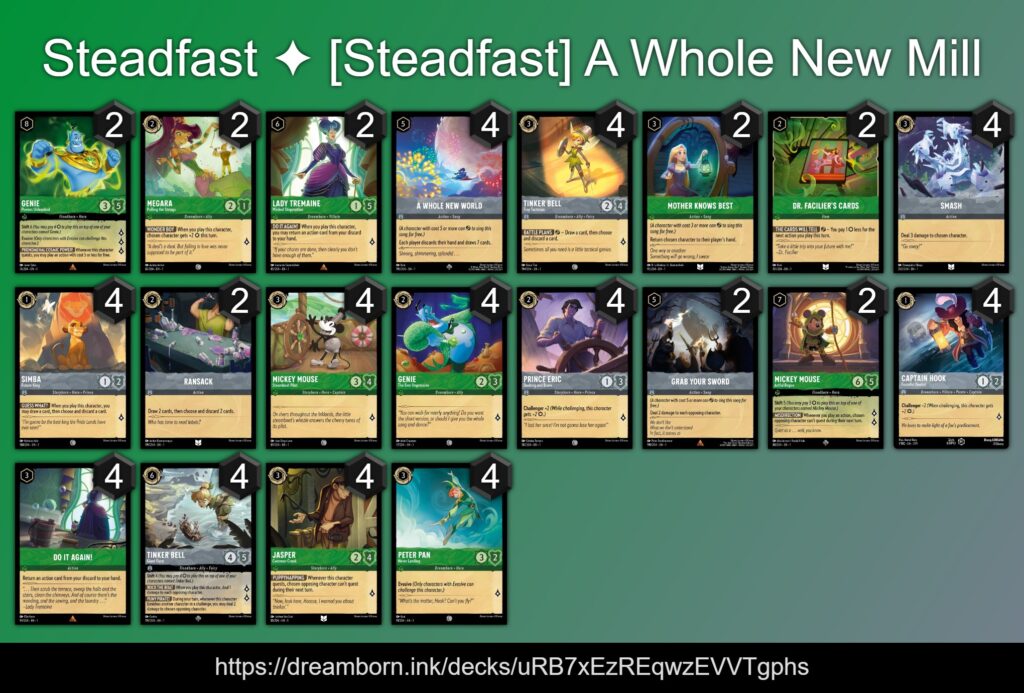
Amber/Steel Musketeers – LorcanaDecklists
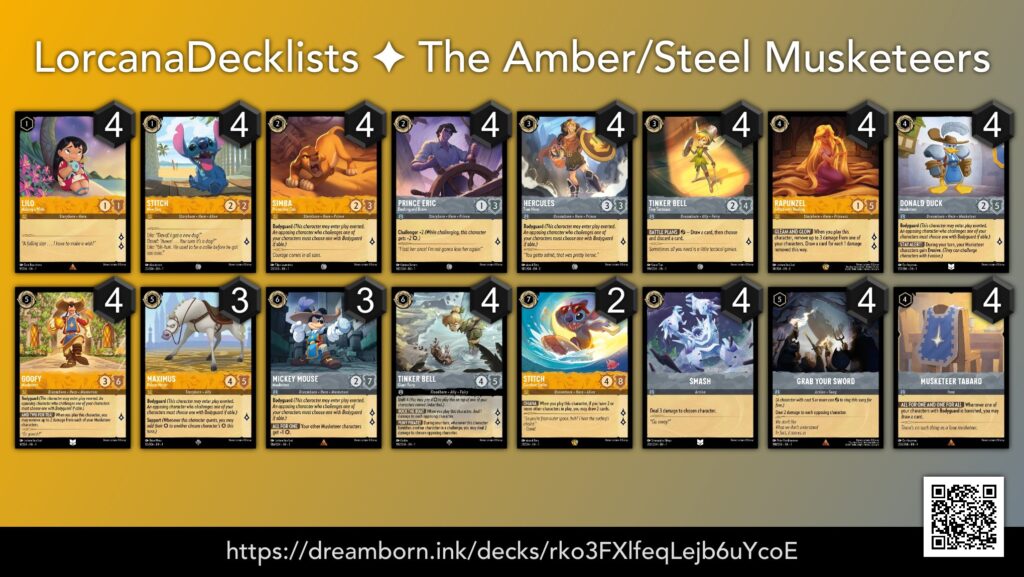
Wrapping Up
If you’ve made it this far, thank you for reading! I hope you enjoyed my first set review. If you’re interested in learning to play Lorcana, wanting to improve your game, or simply looking for fun video content, I recommend checking out my tabletop gameplay videos on Twitch and YouTube.
I typically livestream and publish new Lorcana content three times per week. If you have questions, comments, or would like to submit a decklist for me to play on Lorcana Live, you can reach me on these social platforms or by emailing me at [email protected]
Thanks for reading and happy inking!

